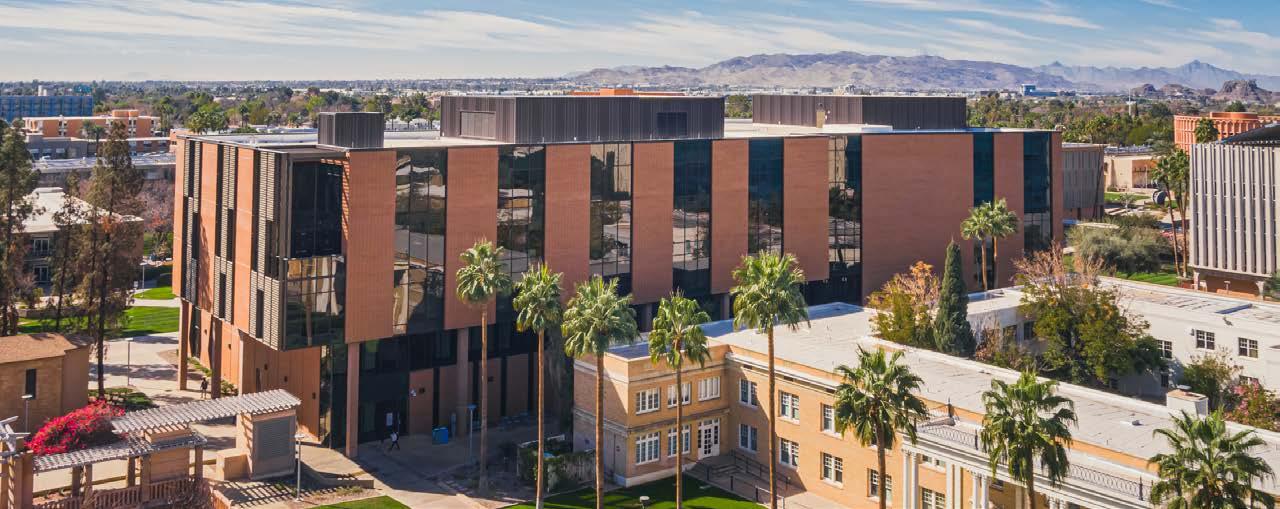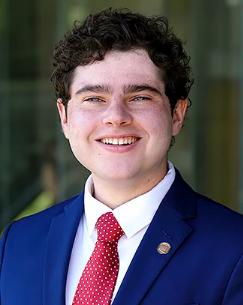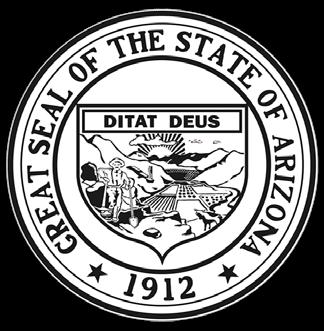


Comprehensive Financial Report
2025 An Enterprise Fund of the State of Arizona.
Year Ended June 30, 2025

Ended June 30, 2025








Comprehensive Financial Report
2025 An Enterprise Fund of the State of Arizona.
Year Ended June 30, 2025

Ended June 30, 2025





Arizona State University has confirmed its position as a financially stable and inclusive institution over the past year. We continue to innovate, make strategic decisions and launch programs to advance our New American University. ASU has grown its endowment, welcomed its largest and most diverse incoming class and is highly ranked by various publications and organizations.
ASU continues to rise as one of the best universities in the nation. We are proud to say that for 11 consecutive years, ASU has been ranked No. 1 in Innovation by U.S. News & World report as well as listing ASU’s online programs among the nation’s best; the Carnegie Foundation and American Council on Education rank ASU as one of 21 Research 1 universities providing broad student access and paths to competitive wages; and the newest Global Employability University Ranking and Survey, GEURS, again ranked ASU second among public U.S. universities for employable graduates, ahead of UCLA, Michigan and Purdue.
ASU’s endowment, managed by the ASU Foundation for A New American University, grew to $1.59 billion in assets. This growth moved ASU up eight spots to rank No. 95 out of 658 colleges, universities and affiliated foundations in the NACUBO-Commonfund Study of Endowments annual report. This expansion showcases exceptional philanthropy and underscores the significant impact of donor support on individuals, research and communities.
ASU launched the Changing Futures campaign in April to increase the endowment to $2.5 billion by June 30, 2029. The assets will help ASU recruit and keep distinguished faculty, support global research and provide affordable education for all qualified students.
Although universities face economic uncertainty and potential threats to research funds, research drives intellectual, social and economic growth. Universities have a unique chance to enhance their influence. We have the talent, means and goodwill to bring more opportunities to more students. ASU’s operations remain merit-based and egalitarian, achieved through innovative, scientific and technological approaches that maximize public service impact.
For instance, we created the ASU Health Hub to house the School of Medicine and Advanced Medical Engineering and the School of Technology for Public Health, educating physicians with expertise in medicine, engineering, technology and the humanities. Graduates will use artificial intelligence and data science to increase patient engagement, pursue leading-edge medical practices and contribute to improved health outcomes.
Two impressive appointments will lead these two new schools. Sarah Hollingsworth Lisanby, former professor emeritus at Duke and a director at the National Institute of Mental Health, will serve as the founding dean of the ASU School of Medicine and Advanced Medical Engineering, and Jyotishman Pathak will serve as the first dean of the new School of Technology for Public Health. Pathak previously held several prestigious positions at Weill Cornell Medicine in New York, including the Frances & John L. Loeb Professor of Medical Informatics, Professor of Health Care Policy and Research in Psychiatry, Chief of the Division of Health Informatics, and Vice Chair for Entrepreneurship in the Department of Population Health Sciences.
While research contributes greatly to Arizona’s overall advancement, ASU is also committed to the fundamental well-being of the communities we serve. One way ASU does this is by significantly boosting Arizona’s economy. One in four working Arizonans holds a bachelor’s degree from ASU, contributing $24.1 billion in wages. Our annual operations also add $6.1 billion to the state’s gross domestic product. We also completed several capital investments, including the state-of-the-art Interdisciplinary Science and Technology 12 research and education building at ASU’s Polytechnic campus as well as the Garden Commons; Casa del Valle and the Academic and Office building at ASU’s West Valley campus; Novus Innovation Corridor, the University Gateway building, the Mill Avenue Residence Hall and Wilson Hall at ASU’s Tempe campus; and the Arizona Golf House, a new facility at Papago Golf Club in Phoenix.
I am pleased to say that we are settling into the 2025–26 academic year, starting with a record enrollment of 42,900 new students this fall. Among them, 9,700 are Arizona high school students, showing that we are the university of choice for Arizona residents. Our enrollment growth sends a simple message: students recognize our research’s practical and positive impact. They know that an incredible community and experience await them here. The myth that a college degree has lost value does not match reality — the demand for ASU is only increasing!
Sincerely,

Michael M. Crow President Arizona State University

October 29, 2025
To President Crow, Members of the Arizona Board of Regents and Citizens of Arizona:
Enclosed is the Arizona State University Annual Comprehensive Financial Report (ACFR) for the year ended June 30, 2025. The report includes the annual financial statements, Management’s Discussion and Analysis (MD&A) and supplemental information to assist the reader in clearly understanding the University’s financial activities and outcomes.
Arizona State University (ASU) management is responsible for the completeness and reliability of the information contained in this report based upon a comprehensive framework of internal controls that was established for this purpose. University management has implemented a system of internal controls that is robust and sufficient to prevent material misstatements and to provide management with reasonable assurance that assets are safeguarded against loss from unauthorized use or disposition. Because the cost of a control should not exceed the benefits that can be derived from it, the objective is to provide reasonable, rather than absolute, assurance that the financial statements are free of material misstatements.
The University’s internal auditors also perform fiscal, compliance, information technology and operational audits. University Audit and Advisory Services prepares an annual audit plan based on ASU’s Enterprise Risk Assessment model. The audit plan is approved by the University President and the Arizona Board of Regents Audit Committee.
State law, federal guidelines, and certain bond covenants require that the University’s accounting and financial records be audited each year. The University’s annual audit is performed by the Arizona Auditor General. The reports resulting from the audit are shared with University management and the Arizona Board of Regents (ABOR). The audit of the University’s federal assistance programs is performed by the Arizona Auditor General in conjunction with the Statewide Single Audit. For the year ended June 30, 2025, the Arizona Auditor General has issued an unmodified opinion on Arizona State University’s financial statements, the most favorable outcome possible. The independent auditors’ report is displayed at the front of the financial section.
ASU remains committed to effective resource planning and sound financial management as it pursues excellence in instruction, research and public service. We have prepared Management’s Discussion and Analysis to provide a narrative introduction, overview and analysis of the basic financial statements, as well as information regarding the University’s financial position and the results of operations for the year ended June 30, 2025. The MD&A immediately follows the independent auditors’ report, complements this letter of transmittal and should be read in conjunction with it.
Profile of the University
ASU was founded in 1885 as the Territorial Normal School by an act of the Thirteenth Territorial Legislature, in response to the growing demand for teachers and leaders in the region. In 1958, after a series of name changes, the citizens of Arizona voted in favor of a ballot initiative to change the name of the institution to Arizona State University. ASU today is composed of four campuses in the metropolitan Phoenix area, centers in both Los Angeles and Washington, D.C., ASU Online, and programs and locations available across Arizona and around the world.
ASU’s charter, mission and goals demonstrate leadership in both academic outcomes and accessibility and affordability. ASU strives to establish national standing in the academic quality and impact of all ASU colleges and schools; to establish ASU as a global center for interdisciplinary research, discovery and development; and to enhance our local impact and social embeddedness. These aspirations provide the framework for ASU’s continued development as a leading, global research university.
ASU offers more than 850 undergraduate and graduate degree programs and concentrations led by expert faculty from highly ranked colleges and schools. Each distinctive academic program exemplifies the hallmark of ASU – an exceptional education inspired by vision, scholarship and creativity. ASU is accredited by the North Central Association’s Higher Learning Commission.
The Arizona Board of Regents, a constitutionally-created body corporate, governs Arizona State University, as well as the state’s other two public universities. ABOR is composed of twelve members, including appointed, ex-officio and student regents. The Governor of Arizona appoints and the Arizona Senate confirms the eight appointed regents to staggered, eight-year terms as voting members of ABOR. The Governor and Superintendent of Public Instruction serve as ex-officio, voting members while they hold office. Two student regents serve staggered two-year terms, the first year as a nonvoting board member and the second year as a voting member
The University is considered a part of the reporting entity for the State of Arizona financial reporting purposes and is included in the State of Arizona Annual Comprehensive Financial Report. Governmental Accounting Standards Board (GASB) Codification Section 2100: Defining the Financial Reporting Entity, and Section 2600: Reporting Entity and Component Unit Presentation and Disclosure, provides criteria for whether certain organizations should be reported as component units based on the nature and significance of their relationship to the related entity. Based on this criteria, the financial reporting entity for ASU’s financial statements is comprised of the University and ten component units. The University’s financial statements and the financial statements for the University’s four blended component units, the Bermuda Institute of Ocean Sciences, the Thunderbird School of Global Management, California College of ASU and the ASU Athletic Facilities District, are prepared in accordance with GASB reporting requirements. Separate financial statements for the University’s six discretely presented component units are compiled in accordance with GASB Statement Nos. 39 and 61, and include ASU Enterprise Partners; Arizona Capital Facilities Finance Corporation (ACFFC); ASU Alumni Association; Arizona State University Research Park, Inc.; ASU Preparatory Academy,
Inc. and Sun Angel Foundation. These component units are non-profit, tax-exempt organizations and are discretely presented based on the nature and significance of their relationships to the University.
The University is responsible for planning, developing and controlling budgets within authorized allocations in accordance with University, ABOR, state and federal policies. The University submits its annual operating budget, to ABOR for approval. The state legislature reviews the University’s local funds budget and adopts and appropriates the general-purpose funds budget through legislation. University colleges and departments utilize financial reports to review financial transactions and monitor budgets. The University also provides quarterly financial reporting to the Arizona Board of Regents. The report includes a comparison of budget to actual revenue and expenses, projections for revenues, expenses and net position for the fiscal year end with variance explanations and an estimate of the University’s monthly liquidity.
The following economic summary is based on the Arizona Office of Economic Opportunity Employment Projections, released on February 20, 2025, and data compiled by the JPMorgan Chase Economic Outlook Center at the ASU W.P. Carey School of Business.
At a national level, the US economy is demonstrating resilience with an economic rebound through the third quarter of the calendar year. As of the third quarter of 2025, real GDP growth accelerated to 3.0 percent, up from a 0.5 percent contraction in the first quarter. According to the Atlanta Fed’s GDPNow model, real GDP growth is expected to slow slightly in the fourth quarter with a projected annualized growth rate around 2.5 percent. In September 2025, the Federal Reserve issued a 25 basis points cut in the federal funds effective rate and signaled that two more rounds of cuts are being considered during the calendar year. These actions are expected to boost economic activity while continuing to counter-balance inflation. Significant economic risks persist including geopolitical tensions, ongoing federal deficits and the impact of tariffs, all of which could dampen economic expansion. Overall, the national economic outlook remains cautiously optimistic.
According to the U.S. Bureau of Labor Statistics, the national labor market remains relatively strong, though growth has moderated. Employee hiring and retention remains a significant challenge across all industries, particularly within the higher education sector. The national unemployment rate as of August 2025 of 4.3 percent reflects a stable job market with robust demand for workers especially in the technology and health care sectors. Wage growth year-over-year as of August 2025 of 3.7 percent, represents two years of wage growth outpacing the national rate of inflation, a trend typically associated with increases in economic productivity. The Arizona unemployment rate of 4.1 percent as of August 2025 is in line with the national average, ending the state’s two year run outperforming the national unemployment rate. In its February 2025 forecast, the Arizona Office of Economic Opportunity is forecasting modest gains in Arizona nonfarm employment, with over 67,000 new nonfarm jobs (1.0 percent annualized growth) expected from 2024 through 2026. Job growth is expected to continue across ten of Arizona's twelve job super-sectors with the health care and construction super-sectors expected to add the largest number of jobs at approximately 27,100 (annualized growth rate of 2.8 percent) and approximately 7,700 (annualized growth rate of 1.7 percent), respectively. Natural resources and mining and information technology are the super-sectors projected to record a loss, approximately 200 jobs (-0.2 percent annualized rate) and 600 jobs (-0.6 percent annualized rate), respectively
The University’s economic outlook is positive due to its scale, diversified revenue sources and research momentum. The University continues to enroll record numbers of students across multiple locations and modalities, giving it pricing power and operational flexibility that many peer institutions lack. For the first time, the University reported more than $1.0 billion in the National Science Foundation Higher Education Research and Development Survey, which underpins federal and industry sponsored awards, tech transfer opportunities and partnerships with the private sector that can offset volatility in tuition-related revenues. Economic challenges persist and the University continues to actively manage reductions in state investment, rebalancing costs to ensure near- and long-term financial stability. National shifts include evolving visa and federal immigration policies that are creating challenges for international students, threatening an important revenue and talent pool of students and future Arizona workers. These combined pressures make affordability and enrollment retention top operational challenges over the next 12 months. Given these factors, the University’s near-term strategy is to leverage its market advantages including acceleration of high-margin online and lifetime learning programs, broadening industry partnerships and sponsored research commercialization opportunities, and continuing to deploy initiatives to increase its revenue profile by leveraging its academic and research assets.
The ASU Public Enterprise, composed of the University, affiliated entities and other partners, continues to evolve and demonstrate new possibilities in line with its design aspirations. The ASU Public Enterprise strategic planning methodology is driven by pursuit of entrepreneurial opportunities in support of efforts to empower and catalyze human development in all forms. The public enterprise approach to higher education constitutes an animating purpose of social transformation, knowledge generation at society-impacting scale, the fundamental assumption of faculty as knowledge entrepreneurs and demonstration of measurable economic and social progress metrics while generating and employing diverse funding mechanisms to support the enterprise.
With the ASU Charter as its guiding principle, Arizona State University has become a national leader in enabling academic excellence and accessibility at scale. ASU remains committed to ongoing institutional redesign to reach the next iteration of the public research university while simultaneously taking fundamental responsibility for the communities we serve. As part of its long-term strategic planning, the University aspires to be the leading global center for interdisciplinary research, discovery and development.
Major milestones of the past year highlight the variety of accomplishments of the University and include the following:
• In June 2025, the Arizona State University endowment reached $1.7 billion in market value of assets. A combination of generous donors, market recovery and strong investment performance boosted the endowment’s market value for Fiscal Year 2025. The endowment is managed by the Investment Committee of the ASU Foundation for a New American University and is a critical component of the University’s diversified revenue-generating portfolio. From July 1, 2024 through June 30, 2025, more than 113,000 individual, corporate and foundation donors made a gift to the ASU Foundation, generating more than $630.8 million in new gifts and commitments to fund scholarships, launch new degrees and advance research, with more than 10 percent of donors giving to ASU for the first time. In 2025, the ASU Foundation celebrated 70 years of advancing the University’s mission.
• As of June 2025, more than 1.2 million unique learners worldwide have enrolled in ASU learning offerings, including through Universal Learner Courses, career certifications and stackable credentials. These programs, created and delivered by ASU’s colleges and schools, are changing where, when and how students learn. Through ASU’s Earned Admissions pathway, 9.000 adult learners have been admitted to the University, returning or entering college for the first time.
• In April 2025, the University was recognized by the Carnegie Foundation for the Advancement of Teaching and the American Council of Education as only one of 21 Research 1 (R1) universities that provide broad access to students and strong paths to competitive wages for their graduates. In the listing, the University was classified as “high access” as it enrolls more Pell and underrepresented minority students than expected given the composition of the student body and as “high earnings” as the median student who starts at ASU will earn considerably more than a group of people of comparable location, age and other demographic factors.
• In November 2024, the University and Deca Technologies were selected by the National Institute of Standards and Technology, part of the U.S. Department of Commerce, a $100 million award for the SHIELD USA initiative. This award will drive innovation in the domestic microchip packaging ecosystem, expand capacity for domestic advanced packaging and help regain U.S. leadership in microelectronics while strengthening national security. This project, focused on organic materials and substrates, will be a vital part of the broader $11 billion CHIPS research and development program.
• In October 2024, HonorHealth became the University’s primary clinical affiliate for the new ASU School of Medicine and Advanced Medical Engineering. Driven by a mutual desire to advance health care through technology and humanity, this agreement will help train future leaders in medicine and medical engineering and improve health outcomes through collaborative and community-focused care. The move marks a significant step forward in the development of ASU Health and represents a collaborative effort to create the clinical education programs needed to serve the citizens of Arizona today and in the future.
• In April 2025, the University launched SPORTx, a new initiative designed to accelerate sports-related entrepreneurial ventures and empower student athletes. In partnership with industry collaborators, GoDaddy and LEAD Venture Corporation, this studio helps studentathletes navigate name, image and likeness opportunities while providing them with education, mentorship and digital brands, including an AI-powered experience known as GoDaddy Airo, to develop, launch and grow business ventures.
Awards and Acknowledgements
The Government Finance Officers Association of the United States and Canada (GFOA) awarded a Certificate of Achievement for Excellence in Financial Reporting to the University for its ACFR for the fiscal year ended June 30, 2024. The Certificate of Achievement is a prestigious national award recognizing conformance with the highest standards for preparation of state and local government financial reports. To receive a Certificate of Achievement, a report issuer must publish an easily readable and efficiently organized ACFR and must satisfy both generally accepted accounting principles and applicable legal requirements. A Certificate of Achievement is valid for a period of one year. The University will submit its ACFR for the fiscal year ended June 30, 2025 to the GFOA and anticipates this year’s report will continue to meet the Certificate of Achievement Program's requirements.
Preparation of this ACFR in a timely manner would not have been possible without the coordinated efforts of the Financial Services Office and other University administrators, faculty and staff. In addition, the Arizona Auditor General provided invaluable assistance. The contributions of all these parties are gratefully acknowledged.
Sincerely,
Morgan R. Olsen
Executive Vice President, Treasurer and Chief Financial Officer Arizona State University

ASU is a comprehensive public research university, measured not by whom it excludes, but by whom it includes and how they succeed; advancing research and discovery of public value; and assuming fundamental responsibility for the economic, social, cultural and overall health of the communities it serves.

For its Annual Comprehensive Financial Report For the Fiscal Year Ended June 30, 2024

Executive Director/CEO

























Lindsey A. Perry, Auditor General
Melanie M. Chesney, Deputy Auditor General
Members of the Arizona State Legislature
The Arizona Board of Regents
Report on the audit of the financial statements
Opinions
We have audited the accompanying financial statements of the business-type activities and aggregate discretely presented component units of Arizona State University as of and for the year ended June 30, 2025, and the related notes to the financial statements, which collectively comprise the University’s basic financial statements as listed in the table of contents.
In our opinion, based on our audit and the reports of the other auditors, the financial statements referred to above present fairly, in all material respects, the respective financial position of the business-type activities and aggregate discretely presented component units of the University as of June 30, 2025, and the respective changes in financial position and, where applicable, cash flows thereof for the year then ended in accordance with U.S. generally accepted accounting principles.
We did not audit the financial statements of the Bermuda Institute of Ocean Sciences (BIOS), the Thunderbird School of Global Management (TSGM), the California College of ASU (CC-ASU), the ASU Athletic Facilities District (AFD), and the aggregate discretely presented component units, which account for the following percentages of the assets and deferred outflows of resources, liabilities and deferred inflows of resources, revenues, and expenses of the opinion units affected:
Those statements were audited by other auditors, whose reports have been furnished to us, and our opinion, insofar as it relates to the amounts included for BIOS, TSGM, CC-ASU, AFD, or the aggregate discretely presented component units, is based solely on the other auditors’ reports.
We conducted our audit in accordance with U.S. generally accepted auditing standards and the standards applicable to financial audits contained in Government Auditing Standards, issued by the U.S. Comptroller General. Our responsibilities under those standards are further described in the auditors’ responsibilities for the audit of the financial statements section of our report. We are required to be independent of the University and to meet our other ethical responsibilities, in accordance with the relevant ethical requirements relating to our audit. We believe that the audit evidence we have obtained is sufficient and appropriate to provide a basis for our audit opinions. The other auditors did not audit the aggregate discretely presented component units’ financial statements, except for the ASU Preparatory Academy, Inc., in accordance with Government Auditing Standards
As discussed in Note A to the financial statements, the University’s financial statements are intended to present the financial position, the changes in financial position, and, where applicable, cash flows of only those portions of the business-type activities, major fund, and aggregate discretely presented component units of the State of Arizona that are attributable to the transactions of the University. They do not purport to, and do not, present fairly the financial position of the State of Arizona as of June 30, 2025, the changes in its financial position, or, where applicable, its cash flows for the year then ended in conformity with U.S. generally accepted accounting principles. Our opinion is not modified with respect to this matter.
Management is responsible for the preparation and fair presentation of the financial statements in accordance with U.S. generally accepted accounting principles, and for the design, implementation, and maintenance of internal control relevant to the preparation and fair presentation of financial statements that are free from material misstatement, whether due to fraud or error.
In preparing the financial statements, management is required to evaluate whether there are conditions or events, considered in the aggregate, that raise substantial doubt about the University’s ability to continue as a going concern for 12 months beyond the financial statement date, including any currently known information that may raise substantial doubt shortly thereafter.
Our objectives are to obtain reasonable assurance about whether the financial statements as a whole are free from material misstatement, whether due to fraud or error, and to issue a report that includes our opinions. Reasonable assurance is a high level of assurance but is not absolute assurance and therefore is not a guarantee that an audit conducted in accordance with U.S. generally accepted auditing standards and Government Auditing Standards will always detect a material misstatement when it exists. The risk of not detecting a material misstatement resulting from fraud is higher than for one resulting from error, as fraud may involve collusion, forgery, Arizona Auditor General | 2910 N 44th St., Ste. 410, Phoenix, AZ 85018-7271 | (602) 553-0333 | www.azauditor.gov
intentional omissions, misrepresentations, or the override of internal control. Misstatements are considered material if there is a substantial likelihood that, individually or in the aggregate, they would influence the judgment made by a reasonable user based on the financial statements.
In performing an audit in accordance with U.S. generally accepted auditing standards and Government Auditing Standards, we:
X Exercise professional judgment and maintain professional skepticism throughout the audit.
X Identify and assess the risks of material misstatement of the financial statements, whether due to fraud or error, and design and perform audit procedures responsive to those risks. Such procedures include examining, on a test basis, evidence regarding the amounts and disclosures in the financial statements.
X Obtain an understanding of internal control relevant to the audit in order to design audit procedures that are appropriate in the circumstances, but not for the purpose of expressing an opinion on the effectiveness of the University’s internal control. Accordingly, we express no such opinion.
X Evaluate the appropriateness of accounting policies used and the reasonableness of significant accounting estimates made by management, as well as evaluate the overall presentation of the financial statements.
X Conclude whether, in our judgment, there are conditions or events, considered in the aggregate, that raise substantial doubt about the University’s ability to continue as a going concern for a reasonable period of time.
We are required to communicate with those charged with governance regarding, among other matters, the audit’s planned scope and timing, significant audit findings, and certain internal control-related matters that we identified during the audit.
U.S. generally accepted accounting principles require that the management’s discussion and analysis on pages 20 through 27, schedule of the University’s proportionate share of the net pension liability on page 66, schedule of the University’s proportionate share of total OPEB liability on page 66, and schedule of University pension contributions on page 67 be presented to supplement the basic financial statements. Such information is management’s responsibility and, although not a part of the basic financial statements, is required by the Governmental Accounting Standards Board, who considers it to be an essential part of financial reporting for placing the basic financial statements in an appropriate operational, economic, or historical context. We have applied certain limited procedures to the required supplementary information in accordance with U.S. generally accepted auditing standards, which consisted of inquiries of management about the methods of preparing the information and comparing the information for consistency with management’s responses to our inquiries, the basic financial statements, and other knowledge we obtained during our audit of the basic financial statements. We do not express an opinion or provide any assurance on the information because the limited procedures do not provide us with sufficient evidence to express an opinion or provide any assurance.
Our audit was conducted for the purpose of forming opinions on the financial statements that collectively comprise the University’s basic financial statements. The combining statements on pages 70 and 71 are presented for purposes of additional analysis and are not a required part of the basic financial statements. Such information is management’s responsibility and was derived from and relates directly to the underlying accounting and other records used to prepare the basic financial statements. The information has been subjected to the auditing procedures applied in the audit of the basic financial statements and certain additional procedures, including comparing and reconciling such information directly to the underlying accounting and other records used to prepare the basic financial statements or to the basic financial statements themselves, and other additional procedures in accordance with U.S. generally accepted auditing standards by us and the other auditors. In our opinion, based on our audit, the procedures performed as described above, and the reports of the other auditors, the combining statements are fairly stated, in all material respects, in relation to the basic financial statements as a whole.
Management is responsible for the other information included in the annual report. The other information comprises the introductory and statistical sections but does not include the basic financial statements and our report thereon. Our opinions on the basic financial statements do not cover the other information, and we do not express an opinion or any form of assurance on the other information.
In connection with our audit of the basic financial statements, our responsibility is to read the other information and consider whether a material inconsistency exists between the other information and the basic financial statements, or the other information otherwise appears to be materially misstated. If, based on the work performed, we conclude that an uncorrected material misstatement of the other information exists, we are required to describe it in our report.
In accordance with Government Auditing Standards, we will issue our report on our consideration of the University’s internal control over financial reporting and on our tests of its compliance with certain provisions of laws, regulations, contracts, and grant agreements and other matters at a future date. The purpose of that report is solely to describe the scope of our testing of internal control over financial reporting and compliance and the results of that testing, and not to provide an opinion on the effectiveness of the University’s internal control over financial reporting or on compliance. That report is an integral part of an audit performed in accordance with Government Auditing Standards in considering the University’s internal control over financial reporting and compliance.
Lindsey A. Perry
Lindsey A. Perry, CPA, CFE Auditor General
October 29, 2025
The Management’s Discussion and Analysis (MD&A) provides readers of Arizona State University’s financial statements an understanding of the financial position and revenue and expense activities for the year ended June 30, 2025. This discussion has been prepared by University management and should be read in conjunction with the financial statements and accompanying notes to the financial statements.
Arizona State University (ASU, University) is a knowledge enterprise committed to knowledge creation, innovation and meaningful impact to the communities it serves. The University is comprised of an educational network of more than 850 accredited undergraduate majors, highly ranked graduate degrees and concentrations. ASU’s Fall 2024 enrollment was almost 153,000 students comprised of nearly 120,000 undergraduate students and 33,000 graduate students, including approximately 73,000 students participating in ASU’s online degree programs. The University is classified as an instrumentality of the State of Arizona and is included as an enterprise fund for financial reporting purposes in the State's Annual Comprehensive Financial Report.
The University’s financial report includes three basic financial statements: the Statement of Net Position; the Statement of Revenues, Expenses, and Changes in Net Position; and the Statement of Cash Flows. Financial information for FY 2024 is included in MD&A to illustrate increases and decreases in comparison to FY 2025 data. The financial statements and accompanying notes along with MD&A have been prepared in accordance with generally accepted accounting principles as defined by the Governmental Accounting Standards Board (GASB) for public colleges and universities.
The University’s financial statements encompass the University and its four blended component units and six discretely presented component units based on the nature and significance of their relationships to the University. MD&A focuses only on the University and blended component units, unless otherwise stated. Information on the component units can be found in the component units’ Statement of Financial Position and Statement of Activities, as well as Note B - ASU Component Units, Note M – Summary Financial Information
for ASU Component Units, and Combining Statements of the nonmajor discretely presented component units.
Highlights for FY 2025
The University strengthened its financial foundation in FY 2025 with a $243 million increase in net position compared to a $194 million increase in FY 2024. This represents the 20th straight year in which ASU reported an increase in net position. At June 30, 2025 the University had total assets of $7.4 billion and net position of over $2.5 billion. Overall, FY 2025 funding sources and uses increased at eight percent and seven percent, respectively from FY 2024.
Tuition and fees are ASU’s primary revenue source (49 percent), with grants and contracts, state appropriations, financial aid grants and auxiliary enterprise activities also providing significant funding sources to the University. $1.9 billion was spent on instruction and academic support related expenses in FY 2025, representing nearly one-half of the University’s total expenses and a four percent increase over FY 2024. Research combined with public service expenses was the second largest expense category with $641 million in FY 2025 expenses, while scholarships and fellowships combined with student services were $621 million, with the categories reflecting a 14 percent increase and 11 percent increase over FY 2024, respectively.
The Statement of Net Position presents the financial position of the University at the end of the fiscal year and reports all assets, deferred outflows, liabilities and deferred inflows, and segregates assets and liabilities into current and noncurrent categories. Assets are resources controlled by ASU that can be used to support its mission and goals. A deferred outflow of resources is a use of net position that is applicable to future reporting periods. Liabilities are obligations of the University. A deferred inflow of resources is the acquisition of net position that is applicable to future periods.
The change in net position (assets plus deferred outflows of resources less liabilities less deferred inflows of resources) between years is one indicator of whether the overall financial condition of the University has improved or worsened during the fiscal year.

A summary comparison of the University’s financial position as of June 30, 2025 and June 30, 2024 follows.
Summary
Total assets at June 30, 2025 of $7.4 billion reflect a seven percent increase from June 30, 2024. Current assets are used to support operations and include cash and cash equivalents, short-term investments and accounts receivable. Current assets increased $143 million between years primarily due to increases in cash and cash equivalents and short term investments. Cash and cash equivalents increased $53 million due to operating revenues outpacing expenses as well as up-front receipts of significant grants associated with the Mastercard Foundation Scholars Program and significant microelectronics-related grants. Short-term investments increased $65 million as the University strategically invested available cash balances to maximize returns and maintain reasonable liquidity to fund short-term obligations. Receivables increased $27 million between years due to growth in student tuition and fee billings and increases in sponsored research activities.
Noncurrent assets increased $317 million between years primarily due to a $252 million increase in net capital assets, $28 million increase in endowment investments, $161 million increase in long-term investments and a $4 million increase in OPEB assets, partially offset by decreases in restricted cash and cash equivalents of $125 million. The increase in net capital assets is attributable to completion of the Wilson Hall (Tempe Campus Academic & Office Space), University Gateway (Tempe Campus Academic & Office Space) and West Campus Academic
& Office Space buildings. ASU’s endowment investments increased primarily due to market realized and unrealized gains in investments. ASU's endowment investments are managed by the ASU Foundation for a New American University. Other investments increased due to portfolio balancing efforts to conform with ASU’s overall investment strategy and to ensure maximum yet prudent returns on the University’s operating liquidity. Restricted cash and cash equivalents decreased due to capital project expenses funded by prior year issuances that were reimbursed during the fiscal year for the aforementioned projects and the initial draw on the 2025C System Revenue and Refunding Bonds proceeds. The decrease in restricted cash and cash equivalents was partially offset by the issuance of the 2025C System Revenue and Refunding Bonds to fund a portion of the Interdisciplinary Science and Technology Building 12 and financing bundles for various utilities projects, research lab renovations, academic and classroom renovations, infrastructure and deferred maintenance, and IT infrastructure.
Deferred outflows of resources increased $23 million between years primary due to an increase in pensionsrelated activities as a result of actuarial differences between expected and actual experience as well as changes in actuarial assumptions, partially offset by a decrease in other postemployment benefits-related activities.
Total liabilities increased $265 million for the year ended June 30, 2025 to $4.7 billion, with current liabilities increasing $310 million between years primarily due to increases in the current portion of long-term debt, unearned revenues, accounts payable and compensated absences. The current portion of long-term debt increased $152 million primarily due to the issuance of the 2025C Variable Rate Demand System Revenue Bonds of which the entire principal balance outstanding is required to be classified as a current liability. Unearned revenues increased $107 million due to an increase in fixed grant awards and their corresponding grant revenues being received prior to all grant obligations being fulfilled resulting in the recognition of the revenue in future periods. Accounts payable increased $40 million primarily due to timing of payments associated with payroll-related and other accrued liabilities at year end.
Noncurrent liabilities decreased $45 million between years with long-term debt decreasing by $124 million, partially offset by pension liabilities increasing $34 million, noncurrent lease liabilities increasing $20 million, subscription liabilities increasing $13 million and a $6 million increase in the University’s proportionate share of its OPEB liabilities. Long-term debt decreased due to debt service principal payments on existing issuances. As described above, long-term debt did not increase for FY 2025 because the 2025C Variable Rate Demand System Revenue Bonds are required to be entirely reported as a current liability. Pension liabilities increased due to increases in actuarial longterm liabilities for the plans exceeding growth in the plans
investment assets. Noncurrent lease liabilities increased due to the extension of the University’s long-term lease on the ASU Brickyard building, owned by the ASU Foundation. Subscription liabilities increased due to the execution of new enterprise Salesforce and Instructure subscriptions. The increase in the OPEB liability was due to actuarial differences between expected and actual experience relative to economic and participant demographic factors.
Deferred inflows of resources decreased $24 million between years due to decreased pensions and other postemployment benefits actuarial changes in assumptions in the measurement of the plan liabilities to be recognized in future periods.
Net position increased $243 million between years to over $2.5 billion. ASU’s increase in net position over the last ten years has averaged $148 million annually, allowing the University to accumulate unrestricted net position sufficient to absorb the reductions to net position related to accounting treatments for its pension plans, OPEB liabilities and compensated absences and still retain positive unrestricted net position to support strategic initiatives. Net position is reported as follows:
• Net investment in capital assets represents the University’s investment in capital assets such as equipment, buildings, land and infrastructure, net of accumulated depreciation/amortization and outstanding debt obligations related to those capital assets.
• Restricted-nonexpendable net position primarily represents the University’s permanent endowment funds received from donors for the purpose of creating enduring funding streams for specific programs or activities. These funds are held in perpetuity and are not available for expenditure by the University. The earnings on these funds support the programs and activities as determined by donors.
• Restricted-expendable net position is the resources which the University is legally or contractually obligated to spend in accordance with restrictions placed by donors, grantors or other external parties.
• Unrestricted net position is composed of all other funds available to the University for purposes related to its mission. Unrestricted net position is typically designated or committed for specific academic programs, research initiatives, strategic investments or capital projects.
Statement of Revenues, Expenses, and Changes in Net Position
The Statement of Revenues, Expenses, and Changes in Net Position presents the University’s operating results for the fiscal year. A positive increase in net position would typically indicate the financial condition of the University has improved over the prior year. In accordance with GASB standards, the University recognizes certain essential revenues such as
state appropriations, financial aid grants, and private gifts, as nonoperating revenues even though those revenues are used to support the University’s core instructional mission and are a significant component of the University's funding model.
A summary comparison of the University’s activities for FY 2025 and FY 2024 follows.
Condensed Summary of Revenues, Expenses, and Changes in Net Position (Dollars in millions)
Operating revenues represent resources generated by the University to fulfill its core instruction, research, and public service missions. Student tuition and fees, research grants and contracts, and auxiliary enterprise activities are the primary operating revenues of the University.
Operating revenues increased $310 million, or 11 percent, to $3.2 billion in FY 2025 with the most significant increases occurring in net tuition and fees and research grants and contracts. The $156 million increase in net tuition and fee revenues is primarily the result of a five percent increase in FTE enrollment, inclusive of overall online enrollment growth of 12 percent and increased tuition rates of 1.5 percent for immersion resident students and three percent for nonresident and international students. Online undergraduate tuition for all cohorts increased two percent and non-resident graduate student tuition increased four percent and included various increases in college fees. Additionally, the University implemented a mid-year tuition surcharge to mitigate current year decreases in state investment. Research grants and contracts increased $112 million, or 22 percent, due to increased sponsored and industry-funded research award activity, particularly for semiconductor-related capital infrastructure and federally-sponsored research grants
funded by the U.S. Department of Defense, and the U.S. Department of Energy.
Expenses are categorized as operating or nonoperating per GASB. The University reports operating expenses by functional category (instruction, research, etc.) in the Statement of Revenues, Expenses, and Changes in Net Position and displays expenses by their natural classification (personal services and benefits, supplies and services, scholarships and fellowships and depreciation/ amortization) in Note I – Operating Expenses by Natural Classification
Operating expenses increased $255 million, or seven percent, in FY 2025 with the increase largely reflecting growth in instruction and academic support, research and public service activities and scholarships and fellowships. Research and public services activities represents the largest category of expense growth, an increase of $78 million, due to increased sponsored awards activities, primarily related to enterprise-wide awards for capitalintensive research projects. Instruction and academic support increased $71 million due to increased enrollment and corresponding instructional and programmatic
demands including faculty FTE growth of four percent and staff FTE growth of five percent. Scholarships and fellowships and student services increased $60 million due to increased institutional investments in financial aid for incoming first year students.
Pensions and other postemployment benefits (OPEB) expenses decreased $27 million in FY 2025 impacting all functional classifications. Pensions expense decreased due to recognition of actuarial differences between expected and actual experience as well as changes in actuarial assumptions. OPEB expenses decreased due to an increase in the actuarially-determined discount rate.
Due to the required classification of key revenue sources such as state appropriations, financial aid grants, and private gifts as nonoperating revenues, operating expenses will typically exceed operating revenues for public universities, resulting in an operating loss each year. Total nonoperating and capital revenues increased $21 million between years, primarily due to a $70 million increase in financial aid grants, primarily Pell grants, a $16 million increase in net investment income, a $12 million increase in Technology and Research Initiative Funds (TRIF)
allocations from the Arizona Board of Regents and a $10 million increase in capital commitments, partially offset by a $70 million decrease in nonoperating grants and contracts and a $17 million decrease in total state appropriations. The increase in financial aid grants is related to Pell grant activity tied to enrollment increases and expanded federal Pell grant eligibility and Pell grant amounts that students are eligible to receive. Net investment returns increased between years due to realized and unrealized market gains on operating and endowment investments due to the favorable position of equity markets and increases in interest earnings on operating fund investments due to the federal funds effective rate in place for the duration of the fiscal year. TRIF allocations increased due to ABOR targeted investments in ASU Health and capital commitments increased due to current year receipts of new SPEED subsidies associated with the issuance of the 2024 SPEED Revenue and Refunding Bonds and current year receipts from HonorHealth, the University’s new clinical partner. Nonoperating grants and contracts decreased $65 million due to the expiration of COVID relief federal grants awarded to the University directly and pass-thru grants from the State of Arizona. State appropriations decreased $17 million primarily due to decreases in Arizona Teachers Academy and Arizona Promise appropriations from the Arizona Board of Regents.
A summary comparison of cash flows for the University’s FY 2025 and FY 2024 activities follows.
The Statement of Cash Flows provides additional information about the University’s financial results by reporting the major sources and uses of cash and cash equivalents. Cash flows from operating activities presents the net cash generated or used by the operating activities of the University. Due to the categorization of operating and nonoperating revenues and expenses by GASB, cash flows from operating activities are typically a net cash use. Major operating funding sources include student tuition and fees, research grants and contracts and auxiliary enterprises
revenues. Operating expenses include employee salaries and benefits, vendor payments for services and supplies and student aid outflows. Net cash flows from noncapital financing activities is a major funding source for operating expenses and includes cash from state appropriations, nonoperating grants and contracts, financial aid grants, and private gifts. Cash flows from capital financing activities include all capital assets and related long-term debt activities, including proceeds from the issuance of debt, capital asset purchases, and principal and interest paid on long-term debt. Cash flows from investing activities show the net sources and uses of cash related to purchasing or selling investments and income earned on those investments.
The University is required by state statute and Arizona Board of Regents policy to prepare an annual Capital Improvement Plan (CIP). The CIP details the University’s four-year strategic plan for space utilization and anticipated capital investments to enable the success of current and future students. The CIP outlines plans to issue debt to finance capital acquisitions or construction to address academic, research and student programming needs.
The University’s capital assets, net of accumulated depreciation/amortization and deletions, increased by $252 million in FY 2025, a six percent increase over FY 2024, due to new capital projects, equipment acquisitions and new subscription and leasing activities.
Significant FY 2025 new capital projects included the following:
• Bateman Physical Sciences Center H Wing Modernization. This project will renovate the existing academic and research space including building infrastructure systems, 17 wet labs, 15 dry labs and 24 offices. This will increase reliability of utility services and expand research capabilities in the existing building.
• Polytechnic Student Union Expansion. This project will include a renovation of the existing 32,600 gross square feet Student Union and an approximately 68,000 gross square feet expansion to the east of the existing building on the ASU Polytechnic Campus. This project will expand food service and dining facilities, provide additional office, lounge, meeting and storage spaces for student organizations and clubs, update the campus store, provide exterior event and seating space as well as add classrooms and office space for departments that provide student support.
Additional information about the University’s capital assets is presented in Note D – Capital Assets.
A summary of the University’s outstanding debt including average interest rates, final maturity and outstanding balances for its bonds, certificates of participation and
financed purchases, is presented in Note E – Long-Term Debt. In May 2025, the University issued $154 million in system revenue and refunding bonds to fund the Tempe District Utility Plant, research lab renovations, a portion of the ISTB 12 building and various bundled projects.
ASU’s current system revenue bond ratings are Aa2 by Moody’s Investor Services and AA by Standard and Poor’s with a stable outlook.
ASU has blended financial activity for four of its component units, the Bermuda Institute of Ocean Sciences, the Thunderbird School of Global Management (TSGM), California College of ASU and the ASU Athletic Facilities District.
For its discretely presented component units, the University presents the financial statements on separate pages from the University’s basic financial statements. These component units are reported in distinct financial statements due to their use of different financial reporting models than the University and to emphasize their financial and legal separation from the University. ASU component units that are discretely presented in these statements include: ASU Enterprise Partners (ASUEP); Arizona Capital Facilities Finance Corporation (ACFFC); ASU Alumni Association; Arizona State University Research Park, Inc.; Sun Angel Foundation; and ASU Preparatory Academy, Inc. Even though these component units support the University, they are not subsidiaries of the University and the University is not financially obligated for their ongoing activities or liabilities.

During the year ended June 30, 2025, the Arizona Capital Facilities Finance Corporation, a discretely-presented component unit, identified an error in the yield rates used to calculate bond premium amortization for both the Sun Devil Energy Center LLC and McAllister Academic Village LLC (Hassayampa) bonds. As a result, previously reported net assets (deficit) was restated for the year ended June 30, 2024 decreasing beginning net assets $7 million.
The ASU Public Enterprise reflects the financial activity of the University and its discretely presented component units and resulted in an increase in net position/net assets of $513 million for FY 2025, including a $243 million increase for the University and its blended component units and a $270 million increase for the discretely presented component units. Revenues for the discretely presented components units increased $128 million, or 22 percent, between years primarily due to a $145 million increase in contributions, a $6 million increase in sales and services revenues, partially offset by a decrease in net investment returns of $13 million and other revenues of $12 million. Expenses for the component units decreased by $7 million,
or two percent, between years with a decrease in payments to benefit ASU of $7 million. Payments to benefit ASU include: gift transfers from the ASU Foundation, payments to vendors on behalf of the University, scholarship fund transfers and rent payments to the University from the discretely-presented component units.
ASU Public Enterprise revenues are presented as gross amounts, excluding the impact of scholarship allowances, which are presented as operating expenses of the ASU Public Enterprise. Financial impacts of transactions between the University and its discretely presented component units during the fiscal years presented are not eliminated in this presentation and are presented consistent with the amounts reported in the audited financial statements for each entity.
The net position increase for the ASU Public Enterprise at June 30, 2025 of $506 million included a $196 million increase in the University and its component units unrestricted net position/net assets without donor restrictions, $79 million increase in net investment in capital assets and a $231 million increase in restricted net position, partially offset by the $7 million reduction to ACFFC's beginning net assets for a correction of an
error. The University’s discretely presented component units unrestricted net assets increased by $45 million while temporarily restricted and permanently restricted component units net assets increased by $72 million and $146 million, respectively. Restricted net position/net assets for the ASU Public Enterprise represent balances that must be spent in compliance with donor or grantor specifications.
Arizona State University remains financially sound with a strong and diverse revenue base, sustained enrollment growth model, Changing Futures philanthropic campaign success, acceleration in research volumes and experienced management leadership team. The University’s enrollment trajectory into FY 2026 remains robust, building on recordsetting growth in Fall 2025 with a projected total enrollment of over 158,000 students across its campus immersion and digital immersion educational modalities. The continued growth in digital immersion enrollment, driven by historic demand for ASU Online, is up nine percent to more than 80,000 students as of the Fall 2025 preliminary census. ASU’s overall enrollment levels maintains its status as the nation’s largest public university under a single administration. Retention rates stand at an impressive 85 percent for first-year students, with Arizona residents achieving nearly 89 percent, exceeding national averages for large R1 public research universities and reflecting the success of its targeted interventions like personalized advising and first-generation support programs.
The University’s research enterprise volumes have expanded sixfold over the last two decades, elevating ASU into an elite tier of non-medical school R1 institutions. The University’s innovative approach to applied research of consequential public value has resulted in over 1,600 patents and 250 startups since the beginning of President Crow’s leadership. During 2025, through federal legislation, executive orders and other actions, U.S. colleges and universities have been subjected to numerous federal policy and regulatory changes affecting federally-funded research and other programmatic and compliance activities. The University receives significant funding from federal sources including student financial aid, research grants and other sponsored programs. The University continues to monitor and assess new government regulations and actions that may impact the availability, timing and terms of such funding.
For the upcoming 2025-26 academic year, the University honored its tuition pledge to Arizona undergraduate and graduate residents who are in campus immersion programs which caps an annual increase of three percent or less, consistent with the multi-year tuition setting structure enacted by the Arizona Board of Regents.
Recent recognition for ASU’s innovation and educational efforts from external sources include:
• #1 university in the U.S. for innovation, for all eleven years the ranking has existed; (U.S. News and World Report)
• #1 in the U.S. and top 10 in the world for global impact in research, outreach and stewardship, for the sixth year in a row; (Times Higher Education)
• #1 in the U.S. and #2 in the world for sustainable practices; (Sustainability Tracking, Assessment & Rating System)
• #1 public university in the U.S. chosen by international students; (Institute of International Education)
• #2 in the U.S. for employability among public universities; (Global Employability University Ranking and Survey, 2025)
• Top 5 in the U.S. for total research expenditures among universities without a medical school; (National Science Foundation)
• Top 10 in the U.S. for 2025 Best Colleges for Your Tuition (and Tax) Dollars; (Washington Monthly annual College Guide and Rankings)
Large R1 public research universities confront escalating challenges in FY 2026, including intensified competition for federal research dollars, state-level erosions of investment and public support, and demographic shifts creating economic uncertainties and operational constraints. Rising costs from inflation and infrastructure demands threaten university research volumes and long-term enrollment growth. Universities continue to face the ongoing challenge of recruiting and retaining top faculty and staff in a competitive national labor market. Despite these industrywide challenges, ASU is uniquely primed against these headwinds, leveraging its No. 1 innovation ranking for over a decade and status as the top producer of international and veteran students which, in part, drive its inclusive excellence model. As one of only 21 R1 institutions earning Carnegie’s “high access and high earnings” dual designation, ASU’s scalable, socially-embedded model offers a competitive edge in accessing talent pipelines and driving societal impact, both in service to its Charter to prioritize accessibility, student success and advancing public value.
Cautionary Note Regarding Forward-Looking Statements
Certain information provided by the University, including written as outlined above or oral statements made by its representatives, may contain forward-looking statements as defined in the Private Securities Litigation Reform Act of 1995.
All statements, other than statements of historical facts, which address activities, events or developments that the University expects or anticipates will or may occur in the future contain forward-looking information. In reviewing such information, it should be kept in mind that actual results may differ materially from those projected or suggested in such forward-looking information. This forward-looking information is based upon various factors and was derived using various assumptions.
The University does not undertake to update forwardlooking information contained in this report or elsewhere to reflect actual results, changes in assumptions or changes in other factors affecting such forward-looking information.
Assets
equivalents (Note C)
investments (Note C)
net (Note A)
receivables (Note G)
cash and cash equivalents (Note C)
(Note C)
(Note C)
(Note G)
(Note D)
(Note A)
Deferred Outflows of Resources
(Note F)
(Note K)
(Note E)
(Note K)
$ 2,125,115
Year ended June 30, 2025 (Dollars in thousands)
Operating Revenues
Student tuition and fees, net of scholarship allowances of $689,386
Research grants and contracts, including $457,693 in federal funding, $26,139 in state funding and $146,397 in nongovernmental
(Note I)
Nonoperating Revenues (Expenses)
See Notes to Financial Statements.
ended June 30, 2025 (Dollars in thousands)
from Investing Activities
June 30, 2025
The accounting policies of Arizona State University (ASU, University) conform to U.S. generally accepted accounting principles applicable to public institutions engaged only in business-type activities adopted by the Governmental Accounting Standards Board (GASB).
Reporting Entity
Arizona State University is one of the largest public research universities in the United States under a single administration. Located on four campuses across metropolitan Phoenix, ASU had fall 2024 enrollment of 152,812 students The accompanying statements of the University include the activity of the Tempe campus, West campus (located in northwest Phoenix adjacent to Glendale), Polytechnic campus (located in Mesa) and the Downtown Phoenix campus, and the University’s online degree programs, as well as its component units. Information on component units can be found in Note BASU Component Units and Note M - Summary Financial Information for ASU Component Units.
For financial reporting purposes, the University’s portion of the statements includes those funds directly controlled by the University. Control by the University is determined on the basis of financial accountability. The University is classified as a state instrumentality. Fiscal responsibility for the University remains with the State of Arizona and the University is reported as an enterprise fund in the State of Arizona's Annual Comprehensive Financial Report
ASU’s
The accompanying financial statements of the University include a statement of net position; a statement of revenues, expenses, and changes in net position; and a statement of cash flows, each of which provide a comprehensive, entity-wide perspective of the University. The statement of net position provides information about the assets, deferred outflows of resources, liabilities, deferred inflows of resources, and net position of the University at the end of the fiscal year. Assets and liabilities are classified as either current or noncurrent. Net position is classified according to external donor restrictions, or availability of assets to satisfy the University’s obligations. The statement of revenues, expenses, and changes in net position provides information about the University’s financial activities during the fiscal year. Revenues and expenses are classified as either operating or nonoperating, and all changes in net position are reported, including capital additions and additions to endowments. The statement of cash flows provides information about the University’s sources and uses of cash and cash equivalents during the year. Increases and decreases in cash and cash equivalents are classified as operating, noncapital financing, capital and related financing, or investing activities.
For financial reporting purposes under GASB, the University is considered a public institution engaged only in business-type activities. Accordingly, the University’s financial statements have been presented under the economic resources measurement focus and the accrual basis of accounting. The economic resources measurement focus emphasizes the long-term effects of operations on overall net resources (i.e., total assets, total deferred outflows of resources, total liabilities, and total deferred inflows of resources). The statement of revenues, expenses, and changes in net position prepared using the economic resources measurement focus includes only transactions and events that increase or decrease net position during the year. Under the accrual basis, revenues are recognized when earned and expenses are recorded when an obligation has been incurred, or benefit has been received. All significant intra-university transactions have been eliminated.
Certain amounts have been corrected in the component unit financial statements due to an error identified by the Arizona Capital Facilities Finance Corporation regarding yield rates used to calculate bond premium amortization for both the Sun Devil Energy Center LLC and McAllister Academic Village LLC (Hassayampa) bonds. As a result, previously reported net assets (deficit) has been restated, decreasing beginning net assets $7.4 million.
Summary of Significant Accounting Policies
Cash and cash equivalents. In accordance with GASB Statement No. 9, Reporting Cash Flows of Proprietary and Nonexpendable Trust Funds and Governmental Entities That Use Proprietary Fund Accounting, all highly liquid investments with an original maturity of three months or less, are considered to be cash and cash equivalents. Funds invested in money market funds or through the State Treasurer’s Local Government Investment Pool are also considered cash equivalents. In accordance with GASB, all restricted cash and cash equivalents, including funds held by a bond trustee, are shown as noncurrent cash and cash equivalents.
Endowment Spending Rate Policy. Arizona state law permits the University to expend the entire net appreciation of endowment fund investments. When determining the spending rate for endowment funds, the University administration considers long and short-term needs, total investment return and price level trends and general economic conditions. For FY 2025, the spending rate utilized the constant growth formula which increases spending distributions by the trailing one-year inflation rate (as measured by CPI-U, Consumer Price Index for all Urban Consumers) mid-fiscal year, as long as distributions do not exceed 4.25 percent or fall below 3.25 percent of the trailing 12-quarter average market value of each endowment fund. The inflation rate used was 2.9 percent for FY 2025.
Investments. Short-term, endowment, and other investments are stated at fair value at June 30, 2025. Fair value typically is the quoted market price for investments. Investment returns include interest and dividend earnings, as well as realized and unrealized gains and losses on investments.
Accounts receivable. Total accounts receivable at June 30, 2025 were $489.2 million. Included in the receivables balance are $236.1 million related to tuition and fee payments due from students and others making payments on behalf of students. Additionally, there are $198.0 million in receivables from grant and contract sponsors primarily for the reimbursement of allowable expenses made pursuant to the University’s grants, $10.7 million in accrued interest income, $10.3 million in financial aid donor-selected receipts and $7.9 million in Sun Devil Athletics ticket-related gifts and sponsorship revenues.
Noncurrent student loans receivable. Noncurrent student loans receivable from students bear interest primarily at five percent and are generally repayable in installments to the University over a ten-year period commencing nine months from date of separation from the University. Noncurrent student loans receivable is recorded net of an allowance for estimated uncollectible amounts and related collection costs.
Capital assets. Capital assets are recorded at cost at the date of acquisition. Capital assets that are gifted to the University are recorded at acquisition value at the date of donation. The University’s capitalization policy includes all equipment, works of art and historical treasures with a unit cost of $5,000 or more. In addition, all equipment under a unit cost of $5,000 purchased in bulk for a newly constructed, acquired, or leased facility to become initially operational is also capitalized on a vintage concept basis and depreciated over five years. All library resources acquired for use in University libraries are capitalized as a collection. Intangible subscription right-to-use assets and other intangible assets with a unit price of $5,000,000 or more are subject to subscription accounting or are capitalized, respectively. Intangible right-to-use lease assets of $500,000 or more are subject to lease accounting. New construction, as well as renovations to buildings, infrastructure, and land acquisitions and improvements that have a project cost of at least $100,000 are capitalized. Non-capital equipment and facility costs, routine repairs, and maintenance are charged to operating expenses in the year in which the expense was incurred.
Depreciation is computed using the straight-line method over the estimated useful lives of the assets, generally 40 years for non-research buildings and infrastructure, 10 to 50 years for research buildings, 10 years for library resources, 7 years for intangible assets, and 5 to 12 years for equipment. Intangible right-to-use lease and subscription assets are amortized on a straight-line basis over the shorter of the lease/subscription term or useful
life of the underlying asset. Unless the lease contains a purchase option that the University has determined is reasonably certain of being exercised - then the lease asset is amortized over the useful life of the underlying asset. For additional information, please see Note D - Capital Assets and Note G – Leases and Subscription-Based Information Technology Arrangements. The University does not depreciate works of art and historical treasures that are considered inexhaustible and are held for exhibition, education, research, and public service.
The University utilizes the componentized depreciation method for its research buildings, which is consistent with the method used for government cost-reimbursement purposes. Under the componentized depreciation method, building costs are segregated into component categories with useful lives ranging from 10 to 50 years, and depreciated on a straight-line method basis. Beginning in FY 2025, the University ceased the componentized depreciation method for new construction of research facilities and improvements to existing research facilities.
Compensated absences. Compensated absences are employee vacation leave balances earned but not used at fiscal year end and sick leave balances earned but not used at fiscal year end for leave that is more likely than not to be used in future periods. Vacation leave and sick leave benefits are accrued as a liability on the statement of net position and reported as an expense in the statement of revenues, expenses, and changes in net position.
Unearned revenues. Unearned revenues consist primarily of student tuition and fees and sponsored grants activities related to the ensuing year. Also included are amounts received from athletic and cultural events which have not yet been earned.
Pensions. For purposes of measuring the net pension liability, deferred outflows of resources and deferred inflows of resources related to pensions, and pension expense, information about the pension plan’s fiduciary net position and additions to or deductions from the plan’s fiduciary net position have been determined on the same basis as they are reported by the plan. For this purpose, benefit payments (including refunds of employee contributions) are recognized when due and payable in accordance with the benefit terms. Investments are reported at fair value.
Other postemployment benefits (OPEB). For purposes of measuring the OPEB liability, deferred outflows of resources and deferred inflows of resources related to OPEB, and OPEB expenses, information about the OPEB plans and additions to or deductions from have been determined on the same basis as they are reported by the plans.
Leases and subscription-based information technology arrangements.
The University, as lessee, leases real estate and equipment and determines the classification of the lease at commencement of the contract. For leases that have a maximum possible term of 12 months or less at commencement, assuming all possible lease extensions contemplated in a given lease, the University recognizes an outflow of resources based on the provisions of the contract. For all leases in excess of 12 months and that do not have mutual termination provisions, do not transfer the asset to the University at the termination of the lease, and are exchange or exchange-like transactions, the University recognizes an intangible right-to-use lease asset and a corresponding lease liability. The lease liability is measured at commencement of the lease based on the present value of the future minimum lease payments expected to be made. The lease liability is reduced by the principal portion of the payments made with a corresponding interest expense component. The intangible right-to-use lease asset is initially measured at the value of the lease liability, plus any payments made prior to lease commencement plus direct costs incurred to place the asset into service, less any incentives received prior to commencement.
Key estimates and judgements include the determination of the discount rate used to calculate the present value of the lease payments, the lease term and the lease payments. The University utilizes the rate implicit in the lease when it is readily determinable, otherwise the University employs professional judgement to determine the best estimate, generally derived from the incremental borrowing rate based on the University's most recent taxable debt issuance.
The University’s threshold for lease accounting, as both the lessee and lessor, is for all leases where the present value of the minimum lease payments is $500,000 or more for both equipment and real property.
The University, as lessor, leases real estate and equipment to third parties and determines the classification of the lease at commencement of the contract. For leases where the University is the lessor, a lease receivable and deferred inflow of resources is recognized at the inception of the lease. The lease receivable is recorded at the present value of the future payments using the stated rate in the lease or, if not readily determined, at the University’s incremental borrowing rate utilizing professional judgment as described above. Over the lease term, the University recognizes revenue from interest income and the amortization of the deferred inflow of resources on a straight-line basis.
Subscription-based information technology arrangements (SBITA)
The University’s threshold for SBITA accounting, is for all subscriptions where the present value of the minimum subscription payments is $5,000,000 or more. The University uses its estimated incremental borrowing rate to measure subscription liabilities unless it can readily determine the interest rate implicit in the arrangement. The University’s estimated incremental borrowing rate is calculated using the same methodology as for leases. In addition to recording an intangible subscription right-touse asset and corresponding subscription liability, certain subscription implementation costs are included in the value of the subscription right-to-use assets and amortized over the remaining subscription term.
Net investment return. Net investment return is composed of interest, dividends, and net changes in the fair value of applicable investments associated with realized and unrealized gains and losses.

Derivative instrument - Interest rate swap. In accordance with GASB Statement No. 53, Accounting and Financial Reporting for Derivative Instruments, the University records the hedging derivative instrument on the statement of net position by presenting a liability for the fair value of the derivative instrument at fiscal year end and a deferred outflow of resources.
Net position. The University’s net position is classified based on the following three categories:
• Net investment in capital assets: includes capital assets, net of accumulated depreciation, amortization and outstanding principal balances of debt, lease and subscription obligations attributable to the acquisition, construction, or improvement of those assets.
• Restricted:
• Nonexpendable – gifts that have been received for endowment purposes, the corpus of which cannot be expended.
• Expendable – gifts, grants, contracts, earnings on endowments, expendable gifts that have been received for endowment purposes and other resources that have been externally restricted for specific purposes.
• Unrestricted: all other resources, including those designated by management for specific purposes. Substantially all unrestricted resources are internally designated for academic and research programs, strategic investments and capital projects.
When an expense is incurred that can be paid from either restricted or unrestricted resources, the University’s policy is to allow the department incurring the expense to determine the appropriate funding source. Factors used by departments to determine which resources to use include relative priorities of the department in accordance with the University’s strategic initiatives, externally imposed matching requirements of certain restricted funds, and any pertinent lapsing provisions of the available restricted or unrestricted funding resources. Major capital purchases are regularly split-funded from multiple restricted and unrestricted funding sources.
Revenues/Expenses. Revenues and expenses are classified as operating or nonoperating. Operating expenses are those incurred in conducting the primary programs and services of the University. Operating revenues generally result from exchange and exchange-like transactions. Accordingly, revenues derived from tuition and auxiliary charges are considered to be operating revenues. In addition, grants and contracts for the purposes of providing research are considered operating revenues because of the exchange and exchange-like nature of these activities (i.e., funding is provided to acquire property or activity for the government’s direct benefit). Other revenues, such as state
appropriations, gifts and non-research grants and contracts not generally generated from exchange transactions, are considered to be nonoperating revenues.
Nonexchange grants and contracts include those for the purpose of student financial aid, primarily Pell financial aid grants, and those for purposes other than organized research, since the providers of these grants and contracts do not typically receive direct benefits of equal or significant value, for those grants and contracts. Operating expenses, in accordance with GASB Statement No. 35, Basic Financial Statements—and Management’s Discussion and Analysis—for Public Colleges and Universities—an amendment of GASB Statement No. 34, include salaries, wages, benefits, supplies, services, and depreciation and amortization of capital assets, irrespective as to whether the funding source associated with these expenses are operating or nonoperating revenues. Other expenses, such as interest expense on debt, are considered to be nonoperating expenses.
Scholarship allowances. Student tuition and fee revenues and other student related auxiliary revenues are reported net of scholarship allowances in the statement of revenues, expenses, and changes in net position. Scholarship allowances are the difference between the stated charge for services provided by the University, and the amount that is paid by the students (and/or third parties making payments on a student’s behalf). To the extent that revenues from programs such as Pell grants and University funded scholarships are used to satisfy tuition and fees, and other student charges, the University has recorded a scholarship allowance.
Not included in scholarship allowances is $35.8 million in faculty and staff tuition waivers that are recorded as program expenses on the statement of revenues, expenses, and changes in net position and as personal services and benefits expenses, in Note I - Operating Expenses by Natural Classification
Share of state sales tax - technology and research initiative fund (TRIF). As the governing board of the three state universities, the Arizona Board of Regents (ABOR) administers the portion of the Education 2000 (Proposition 301) sales tax which funds the universities’ TRIF initiatives. ABOR receives funding requests from each university and determines the amount and duration of awards. The Governor and the Legislature receive an annual report from ABOR which includes a detailed set of performance measures used to determine the overall effectiveness of each TRIF funded initiative.
ASU’s component units are separate legal entities controlled and governed by independent boards of directors whose goals are to support the University or have a close affiliation with the University. Even though these organizations support the University or have a close affiliation with the University, they are not subsidiaries of the University and, with the exception of the Bermuda Institute of Ocean Sciences, the Thunderbird School of Global Management, the ASU Athletic Facilities District and California College of ASU, they are neither directly nor indirectly controlled by the University. The University does not have ownership of the financial and capital resources or assets of the component units and does not have the authority to mortgage, pledge, or encumber the assets of these organizations.
Component units can be defined as legally separate entities for which the University is considered to be financially accountable. GASB Statement No. 14, The Financial Reporting Entity and GASB Statement No. 61, The Financial Reporting Entity: Omnibus - an Amendment of GASB Statements No. 14 and No. 34, have set forth criteria to be considered in determining financial accountability. For organizations that previously were required to be included as component units by meeting the fiscal dependency criterion under GASB Statement No. 14, a financial benefit or burden relationship also would need to be present between the primary government and the organization for it to be included in the reporting entity as a component unit. Further, for organizations that do not meet the financial accountability criteria for inclusion as component units are nevertheless included because the primary government’s management determines that it would be misleading to exclude them. GASB Statement No. 61 clarifies the manner in which that determination should be made and the types of relationships that generally should be considered in making that determination.
GASB Statement No. 39, Determining Whether Certain Organizations Are Component Units - an Amendment of GASB Statement No. 14, provides additional criteria for determining whether certain organizations are component units. GASB Statement No. 80, Blending Requirements for Certain Component Units - an Amendment of GASB Statement No. 14, amends the blending requirements for component units that are incorporated as a not-for-profit corporation in which the primary government is the sole corporate member.
Organizations that are legally separate, tax-exempt entities and that meet all of the following criteria should also be considered component units, with discrete presentation. These criteria are (1) the economic resources received or held by the separate organization are entirely or almost entirely for the direct benefit of the University, its component units, or its constituents; (2) the University or its component units, is entitled to, or has the ability to otherwise access,
a majority of the economic resources received or held by the separate organization; (3) the economic resources received or held by an individual organization that the University, or its component units, is entitled to, or has the ability to otherwise access, are significant to the University. Financial statements of these component unit organizations are audited by independent auditors. All of the component units except for the Bermuda Institute of Ocean Sciences have a fiscal year end of June 30, 2025. The Bermuda Institute of Ocean Sciences operates on a calendar year and has a fiscal year end of December 31, 2024. Because the University’s discretely presented component units use a non-governmental generally accepted accounting principles (GAAP) reporting model, the University has chosen to present the discretely presented component units’ aggregated financial information on pages separate from the financial statements of the University. To obtain individual audited financial statements for any of the University’s component units, please contact ASU Financial Services at (480) 965-3601.
The Bermuda Institute of Ocean Sciences (BIOS), a New York nonprofit corporation, is reported as a blended component unit and included in the University’s financial statements. BIOS primarily exists to benefit the University by providing an Atlantic Ocean hub for research and instructional activities. The University directs the activities of BIOS through the BIOS Board of Trustees and through its integration into the operations of the ASU Julie Ann Wrigley Global Futures Laboratory. BIOS holds assets that are material to its overall financial position, primarily the BIOS campus and its research boat fleet, which are all controlled and managed by the University and used to support the University’s research and academic programs.
The Thunderbird School of Global Management (TSGM), an Arizona nonprofit corporation, is reported as a blended component unit and included in the University’s financial statements. TSGM primarily exists to benefit the University by providing a platform for global education programming.
The ASU Athletic Facilities District (AFD), a single university athletic facilities district, is reported as a blended component unit and included in the University’s financial statements. The AFD is formed pursuant to the provisions of Arizona Revised Statutes (A.R.S.) Title 48, Chapter 26 and Maricopa County Resolution No. C-20-12-017-M-00. The AFD supports the University’s efforts to construct, reconstruct, finance, furnish, maintain and improve intercollegiate athletic facilities located on ASU’s property, including utilities, roads, parking areas or buildings necessary for full use of the athletic facilities.
The AFD resides within the Novus Innovation Corridor. California College of ASU
California College of ASU (CC-ASU), a California nonprofit corporation, is reported as a blended component unit and included in the University’s financial statements. CC-ASU is a higher education learning community that promotes creativity, innovation and growth through instruction and collaboration with programs that provide a challenging liberal arts education. CC-ASU primarily exists to collaborate with the University to create and implement programs that are compatible with ASU programs, provide license to and use of CC-ASU IP rights and to strengthen the University’s profile and presence in the California market.
Arizona State University’s discretely presented component units, all Arizona nonprofit corporations, include three major component units, ASU Enterprise Partners (ASUEP), the Arizona Capital Facilities Finance Corporation (ACFFC) and ASU Preparatory Academy Inc. (ASU Prep) and several smaller component units listed below. The University has determined that ASUEP, ACFFC and ASU Prep are major component units based on an evaluation of (1) services provided by the component unit to the University are such that separate reporting as a major component unit is considered to be essential to financial statement users, (2) significant transactions with the University, or (3) significant financial benefit or burden relationship with the University.
A description of the University’s discretely presented component units and the basis for including each as a component unit in the University’s financial report follows.
• ASU Enterprise Partners - disburses resources at the discretion of its independent board of directors, in accordance with donor directions and ASU Enterprise Partners policy. The majority of assets held by the ASU Enterprise Partners are endowments restricted for donor specified programs and purposes, the principal of which may not be spent. The directors of the ASU Enterprise Partners make all decisions regarding the ASU Enterprise Partners business affairs, including distributions made to the University. Affiliates of ASUEP include: Arizona State University Foundation for a New American University (ASU Foundation), ASU Research Enterprise, Enterprise Collaboratory at ASU and Subsidiaries (formally known as Research Collaboratory at ASU), ASU Enterprise Partners Outreach Hub, Skysong Innovations, University Realty LLC and NEWSWELL. In FY 2025, the ASU Enterprise Partners distributed $158.3 million in cash donation transfers to the University.
• ASU Alumni Association - receives funds primarily through donations, dues, and affinity partners, which are used to promote the welfare of the University and its alumni.
• Sun Angel Foundation - receives funds primarily through donations and contributes funds to the University in support of various athletic programs.
The three component units above meet all of the criteria for a legally separate, tax-exempt organization to be reported discretely as a component unit. The economic resources held by these component units are for the direct benefit of the University and the University has the ability to access their economic resources and the economic resources of these component units are significant to the University.
• Arizona Capital Facilities Finance Corporationprovides facilities for use by students of the University or the University itself.
• Arizona State University Research Park, Inc. (Park) - manages a research park to promote and support research activities, in coordination with the University.
Per GASB Statement No. 14, as amended by GASB Statement No. 61, a fiscal dependency and financial benefit/burden exists between the University and these two component units. ACFFC and the Park do not meet the blending requirements since each component unit has a separate board of directors, services provided by the component units do not exclusively benefit the University and the total debt outstanding of the component units is not expected to be paid entirely or almost entirely with University resources.
• ASU Preparatory Academy, Inc. - prepares Arizona K-12 students for success with a university-embedded academic program that empowers them to complete college, compete globally and contribute to their communities. The University is able to impose its will on the entity and the University appoints the voting majority of its board. Additionally, a fiscal dependency and financial benefit/burden exists between the University and ASU Prep. ASU Prep does not meet the blending requirements in GASB Statement No. 14, as amended by GASB Statement No. 61, since its board of directors is not substantively the same as ASU, the services it provides do not exclusively benefit the University, any outstanding debt of the entity is not expected to be repaid from University resources and the University is not the sole corporate member of the entity.
For financial reporting purposes at the University level, only the discretely presented component units’ statement of financial position and statement of activities are included in the University’s financial statements as required by generally accepted accounting principles for public colleges and universities.
The University’s deposits and investments are discussed below in the analysis of deposit and investment risk, as required by GASB Statement No. 40, Deposit and Investment Risk Disclosures—an amendment of GASB Statement No. 3 ; and fair value of investment assets, as required by GASB Statement No. 72, Fair Value Measurement and Application
Included in the University’s deposits and investments are $231.4 million in capital projects and bond debt service funds held in trust and invested with the bond trustee, $342.7 million in cash and cash equivalents, and $1,371.2 million in short-term and other investments. In addition, of $486.9 million in endowment funds, $472.1 million is managed by the ASU Foundation and $14.8 million is part of the Bermuda Institute of Ocean Sciences (BIOS), Inc. endowment. The funds managed by the ASU Foundation, an Arizona nonprofit corporation, are held in pooled endowment funds under a service contract with the ASU Foundation and invested in the ASU Foundation Long Term Investment Pool and the Sustainable Responsible Impact Pool (Pool).
The ASU Foundation is responsible for oversight, establishing investment policies, and management of the Pool. The ASU endowment assets managed by the ASU Foundation are maintained separately in the financial system of the ASU Foundation. The ASU Foundation owns the assets of the Pool. The University has an interest in the Pool, which is considered an external investment to the University. ASU endowment assets share proportionally in Pool activity. The Pool invests in a variety of asset classes, including common stocks, fixed-income, foreign investments, private equity and hedge funds. The ASU Foundation Endowment Pool is not registered with the Securities and Exchange Commission as an investment company.
The ASU Foundation Board of Directors-appointed Investment Committee, which includes members of the ASU Foundation Board of Directors, is responsible for oversight of the Pool in accordance with ASU Foundation and ASU Enterprise Partners policies. The fair value of the University’s position in the Pool is based on the University’s proportionate share of the Pool, which is marked-to-market monthly. For additional information refer to Note MSummary Financial Information for ASU Component Units. The University also participates in the Arizona Student Financial Aid Trust, which was established by the Arizona Board of Regents (ABOR) and is funded by the Arizona State Legislature and student fees.
For non-endowment (operating) funds, Arizona Revised Statutes (Statutes) requires that deposits of the University
not covered by federal deposit insurance be secured through participation in the State of Arizona Collateral Pool administered by the State Treasurer’s Office which holds pledged collateral of at least 102 percent of uninsured deposits in eligible depositories. Further policy regarding deposits is provided by the Arizona Board of Regents. The Statutes do not specifically address investment policy of the universities, rather ABOR policy governs in this area. ABOR policy requires that each university arrange for the safekeeping of securities by a bank or other financial institutions approved by ABOR. ABOR and University investment policies applicable to University investments are consistent with the Arizona State Treasurer’s authorizing statutes and investment policy. Investment of capital project funds are governed by the financing indenture agreements. With regard to endowments, ABOR policy dictates that these funds are to be invested under the direction of an investment committee designated by the president of each university.
At Arizona State University, the Investment Committee is responsible for advising on the definition, development and implementation of investment objectives, policies, and restrictions. However, if donors restrict the investments, ABOR policy requires that the University invest those funds separately as directed by the donor, and the individual endowments bear all changes in value.
ABOR policy addresses limits on concentration of credit risk and interest rate risk, but neither ABOR policy nor the Statutes include any specific requirements on foreign currency risk for investments of the universities. The State of Arizona Board of Investment provides oversight for the State of Arizona Treasurer’s pools. The fair value of a participant’s portion in the pool approximates the value of that participant’s pool shares and the participant’s shares are not identified with specific investments.
Custodial Credit Risk. University policy for its operating funds requires collateralization for repurchase agreements. Beyond this requirement and those established by Statute or ABOR, the University does not have a policy that specifically addresses custodial credit risk. Custodial credit risk is the risk that, in the event of the failure of a counterparty, the University would not be able to recover the value of its investments or collateral securities that are in the possession of an outside party. As of June 30, 2025, the University had $89.4 million of U.S. agency securities held by an outside party that were uninsured and not registered in the University’s name.
Credit Risk. With regard to credit risk, ABOR policy requires that negotiable certificates of deposit, corporate bonds, debentures and notes, bankers acceptances and State of Arizona bonds carry a minimum BBB or better rating from Standard and Poor’s Rating Service or Baa or better rating from Moody’s Investors Service at the time of purchase and
that the investment be sold in an orderly manner or held until maturity without further investments being made if it falls below this credit rating; and that commercial paper be rated by at least two nationally recognized statistical rating organizations (NRSROs) and be of the two highest rating categories for short-term obligations of at least two of the NRSROs. Capital projects and bond debt service funds are invested by the bond trustee in accordance with the applicable financing indenture, generally limited to United States Treasury securities and other Federal agency securities, certificates of deposit (minimum rating of P-1/A-1), commercial paper (minimum rating of P-1/A-1+), and money market funds rated AAAm or better and invested in short-term debt securities. The University does not have a formal policy that specifically addresses credit risk for endowment funds. Endowment funds managed by the ASU Foundation are invested in an unrated external investment pool subject to the ASU Enterprise Partners investment policy. The investment committee directs which investments are held in the Pool and manages the credit risk associated with the Pool by following the credit quality and guideline restrictions as stated in the investment policy.
Concentration of Credit Risk. Other than United States Treasury securities and other federal agency securities, which can represent greater than five percent of total investments, University policy limits investment in a single issuer to five percent or less of the fair value of the total

portfolio. Except for those issuers allowed by policy, the University does not have an investment in any single issuer that exceeds five percent of the overall portfolio. At June 30, 2025, the University had investments in United States Treasuries of $556.3 million or 22.7 percent of total investments.
Interest Rate Risk. ABOR and University policies do not limit the overall maturity of the investments held by the operating and endowment funds, however, the operating fund investment policy includes guidelines addressing diversification and liquidity. The capital projects funds portfolio is not limited as to the overall maturity of its investments, with the funds invested per the financing indentures to coincide with capital spending needs and debt service requirements, which are typically less than three years, with the additional limitation that certificates of deposit and commercial paper have maximum maturities of 360 days and 270 days, respectively.
Foreign Currency Risk. Non-endowment funds may not be invested in foreign-denominated securities, and the University has no non-endowment investments exposed to foreign currency risk. The endowment funds managed by the ASU Foundation are invested in an external investment pool, which include U.S. dollar denominated foreign investments.
The University measures and categorizes its investments using the fair value measurement guidelines established by generally accepted accounting principles. These guidelines establish a three-tier hierarchy of inputs to valuation techniques used to measure fair value, as follows:
• Level 1 - Quoted prices for identical investments in active markets that are accessible at the measurement date;
• Level 2 - Inputs, other than quoted market prices included in Level 1, that are observable, either directly or indirectly;
• Level 3 - Prices or valuations that require inputs that are significant to the fair value measurement and unobservable.
Investments Classified in Fair Value Hierarchy. Investments categorized as Level 1 of the fair value hierarchy are valued using unadjusted prices quoted for identical assets in active, exchange and brokered markets for those securities. Investments categorized as Level 2 of the fair value hierarchy are valued using a matrix pricing technique. Matrix pricing is used to value securities based on the securities’ relationship to benchmark quoted prices. Investments categorized as Level 3 of the fair value hierarchy are valued using various methods. Real estate is valued by using the income approach to measuring fair value which discounts future amounts to a single current amount. When the income approach is used, the fair value measurement reflects current market expectations about those future amounts.
Other Investments at Fair Value. The fair value of a participant’s portion in the State of Arizona LGIP (Pool 5) approximates the value of that participant’s pool shares and the participant’s shares are not identified with specific investments. Investments in the State Treasurer’s investment pools are valued at the pool’s share price multiplied by the number of shares the University held. The fair value of the University’s position in the ASU Foundation Endowment Pool is based on the University’s proportionate share of the Pool, which is marked-to-market monthly.
Construction in progress represents expenses for approved capital projects which are generally funded with system revenue bonds. It is estimated $58.8 million in additional
expenses will be required to complete the approved projects under construction at June 30, 2025. Construction in progress encumbrances committed through purchase orders at June 30, 2025, totaled $50.5 million.
Capital asset activity for the year ended June 30, 2025 follows:
Capital asset activity for the year ended June 30, 2025 (Dollars in thousands)
1
As of June 30, 2025 the University had issued a combination of fixed and variable rate bonds, fixed rate certificates of participation (COPs), direct placements and financed purchases, of which $2.7 billion is outstanding. The University’s long-term obligations generally are structured with semi-annual interest payments and call options at a prescribed date.
The University has pledged gross revenues as defined in the bond indentures towards the payment of debt related to various senior lien system revenue bonds outstanding at June 30, 2025. These related system revenue bonds are primarily for new academic and research facilities, academic and laboratory renovations, and technology and infrastructure improvements. The pledged revenues include student tuition and fees, certain auxiliary enterprise revenue, net investment income, and indirect cost recovery revenue. Pledged revenues do not include state appropriations, gifts, endowment income, or other restricted revenues. For the year ended June 30, 2025, pledged revenues totaled $2.79 billion of which 6.4 percent ($178.6 million) was required to cover debt service payments.
In May 2025, the University issued $154.3 million of variable rate demand system revenue bonds, Series 2025C, with an average maturity of 17.3 years and a final maturity of July 1, 2055. The bonds bear interest at a weekly rate not to exceed 12% per annum based upon prevailing market conditions, as determined by a remarketing agent. Pursuant to the bond trust agreement, the bonds are subject to conversion, at the option of the Arizona Board of Regents on behalf of the University, to a different adjustable rate mode, or to a fixed rate mode. The interest rate in effect for the bonds on June 30, 2025, was 2.02%.
The Series 2025C bonds were issued to fund the construction and improvements to the Tempe District Utility Plant, Research Lab Renovations, Academic and Classroom Renovations, Infrastructure and Deferred Maintenance, Polytechnic Campus Utility Expansion, Tempe Campus West Quadrant Utility Expansion, IT Infrastructure, and an Interdisciplinary Science and Technology Building.

In addition to the Series 2025C variable rate bonds, the University has two series of variable rate demand system revenue refunding bonds outstanding, Series 2008A and Series 2008B, totaling $56.7 million with final maturities of July 1, 2034. The interest rate in effect on June 30, 2025, was 2.00 percent for the Series 2008A and 2008B bonds.
The University’s variable rate demand bonds have demand features which allow bondholders to "put" debt back to the University. The variable rate bonds are subject to purchase on demand from bondholders, at a price equal to principal plus accrued interest, with seven days’ notice by the bondholder to the remarketing agent.
As of May 4, 2016 the University executed a self-liquidity facility agreement to provide liquidity if any variable rate demand bonds are "put" back to the University by bondholders and not resold by the remarketing agent. Self-liquidity is provided by the Arizona Board of Regents, from cash and investments of the University.
It is the University’s intent to repay its variable rate demand bonds in accordance with the maturities set forth in the official statements. However, in accordance with GASB Interpretation No. 1, Demand Bonds Issued by State and Local Government Entities, in the absence of a “take out” agreement to convert those “put” bonds that cannot be resold by the remarketing agent into some other form of long-term obligation, the University has classified the principal balances outstanding on the Series 2008A, 2008B, and 2025C variable rate demand bonds as current liabilities.
In June 2008, the State of Arizona Legislature approved the Stimulus Plan for Economic and Educational Development (SPEED) which provides Arizona universities with capital improvement funds for critical construction and deferred maintenance projects. SPEED projects are debt financed with revenue bonds and repaid primarily with Arizona Lottery revenues. Specifically, up to 80 percent of SPEED debt service is paid from Arizona Lottery revenues, with the balance being the responsibility of the University as evidenced by the subordinated pledge of University revenues.
The University has three series of Certificates of Participation (COPs) not issued as Direct Placements, the Series 2006 COPs, the 2011A Mercado Refunding COPS, and the 2013A Refunding COPs. The University utilizes COPs to acquire buildings, equipment, and land. COPs are generally callable and collateralized by the acquired asset which is subject to a leasehold interest by the trustee. In the event of a default, the underlying asset value would be removed from the University’s financial statements.
The University has two series of direct placement Certificates of Participation (COPs), the Series 2014 Refunding COPs and the 2017 Refunding COPs. The direct placement COPs were issued with similar terms to the University’s other COPs with no acceleration or priority provisions.
In October 2003, the University entered into a 30-year financed purchase agreement with ASUF, LLC, an Arizona limited liability company, of which the sole member is the University Realty LLC, an Arizona limited liability company, whose sole member is ASU Enterprise Partners, an Arizona nonprofit corporation and component unit of the University, to occupy four floors of office space in the Fulton Center and the related parking structure.
In July 2005, the University entered into a 34-year financed purchase agreement with McAllister Academic Village, LLC, an Arizona limited liability company, whose sole member is the Arizona Capital Facilities Finance Corporation (ACFFC), to utilize the nonresidential portion of the McAllister Academic Village (MAV), which operates under the name of Hassayampa Academic Village. ACFFC has overall responsibility for the residential portion, comprising approximately 92 percent of the facility, with the University maintaining the nonresidential portion of the facility.
In November 2008, the University committed to an intergovernmental agreement with the City of Phoenix related to construction of the fourth and fifth floors of the Nursing and Health Innovation building at ASU’s Downtown Phoenix campus.
Future pledged revenues required to pay all remaining debt service for the University’s senior and subordinate revenue bonds through final maturity of July 1, 2055 total $3.7 billion. In addition to a senior pledge of revenues for ASU system revenue bonds, the University has pledged the same revenues on a subordinated basis to secure the ASU SPEED revenue bonds.
The Taxable Series 2010A System Revenue Bonds were issued as Build America Bonds under the provisions of the American Recovery and Reinvestment Act (ARRA). As such, the University is eligible to receive Federal Direct Payments from the United States Treasury equal to 35 percent of the interest owed on each interest payment date. The amount paid to the University by the Federal government may be reduced or limited due to such issues as failure by the University to submit the required information, offsets to reflect any amounts owed by the University to the Federal government, or changes in the law that would reduce or eliminate such payments. The Series 2010A bonds maturing after July 1, 2024, were refunded on May 10, 2024 as part of the Series 2024 System Revenue and Refunding Bonds.
Securities and cash restricted for bonds and COPs debt service held by the trustee at June 30, 2025 totaled $140.9 million and $3.7 million, respectively. Payment commitments to investors, including interest, for bonds, COPs and other lease obligations, using the interest rate in effect at June 30, 2025 for variable rate issues, are as follows:
The University issued senior system revenue bonds in September 2025 with principal of $60.0 million to finance capital projects and principal of $256.3 million to partially or fully refund series 2015A, 2015B, 2015D, and 2016A bonds.
The Arizona Board of Regents, on behalf of the University, currently plans to issue principal of approximately $215.6 million in additional parity bonds and $61.8 million in subordinate SPEED revenue bonds for capital projects prior to calendar year end 2026.
Effective January 1, 2007, the University entered into a $103 million notional amount swap agreement (hedging derivative instrument) expiring on July 1, 2034, in conjunction with the 2008 variable rate demand system revenue refunding bonds (2008 Bonds). The outstanding $56.4 million notional amount at June 30, 2025 is not exchanged; it is only the basis on which the interest payments are calculated and it decreases as principal payments are made on the 2008 Bonds. The intention of the swap is to effectively convert the variable rate interest on the 2008 Bonds to a synthetic fixed rate. Under the terms of the swap agreement, the University pays the counterparty interest calculated at a fixed rate of 3.91 percent and receives payments from the counterparty based on the Securities Industry and Financial Markets Association (SIFMA) Municipal Swap Index set weekly. The SIFMA rate at June 30, 2025 was 1.92 percent. At June 30, 2025, the synthetic fixed interest rate on the bonds was:
The swap exposes the University to basis risk should the weekly SIFMA rate paid by the counterparty fall below the weekly interest rate due on the bonds. As of June 30, 2025, the University was not exposed to credit risk because the swap had a negative fair value. However, should interest rates change and the fair value of the swap become positive, the University would be exposed to credit risk in the amount of the derivative’s fair value. The swap counterparty was rated AA by Fitch, A+ by Standard & Poor’s and Aa1 by Moody’s Investor Services as of July 1, 2025.
Based on current ratings, the counterparty was not required to provide collateral. In the event a rating downgrade occurs, the counterparty may be required to provide collateral if the University’s overall exposure exceeds predetermined levels.
The University continues to pay interest to the bondholders at the variable rate provided by the bonds. However, during the term of the swap agreement, the University effectively pays a fixed rate on the debt. If the counterparty defaults or if the swap is terminated, the University will revert to paying a variable rate. A termination of the swap agreement may also result in the University making or receiving a termination payment.
The University is exposed to interest rate risk based on the SIFMA indexed variable payment received from the counterparty versus the variable rate paid to bondholders.
Collateral may be held by the University or a third party custodian. As of June 30, 2025, the swap had a fair value of $(2.7) million, which represents the cost to the University to terminate the swap. The June 30, 2024 fair value was $(2.4) million. The fair value was developed by an independent third party, with no vested interest in the transaction, using the zero coupon discounting method. This method calculates the future payments required by the swap, assuming the current forward rates implied by the U.S. Treasury yield curve are the market’s best estimate of future spot interest rates. These payments are then discounted using the spot rates implied by the current U.S. Treasury yield curve for a hypothetical zero-coupon rate bond due on the date of each future net swap settlement. In accordance with GASB 53, Accounting and Financial Reporting for Derivative Instruments , the fair value of the University’s hedging derivative instrument is reported on the statement of net position as a deferred outflow of resources and a liability (derivative instrument).
The University has entered into leases with various entities for classroom, office, research and student housing and activity space. The following leases constitute significant right-to-use lease assets and corresponding lease liabilities for the University:
Brickyard. In July 2004, the University entered into a 25 year master lease of the Brickyard, owned by the ASUF Brickyard, LLC, an Arizona limited liability company, of which the sole member is University Reality, LLC, an Arizona limited liability company, whose sole member is ASU Enterprise Partners. The majority of the facility is being used by the University for classrooms, offices and research areas, with the remaining portion being leased by the University to various firms for retail and restaurant operations. In June 2025, the University extended the lease for an additional 10 year term through July 2044.
SkySong. In June 2006, the University entered into a 15 year lease, for approximately 80,000 square feet of office space within a development known as SkySong. The University’s use of the leased space focuses on supporting entrepreneurial activities and interdisciplinary research programs in engineering-related fields and education technology. The University has since entered into multiple extensions and subsequent leases within the SkySong development for an additional 72,212 square feet of office space for similar uses.
Herald Examiner Building. In August 2018, the University entered into a 12 year lease for 85,118 square feet of office space known as Herald Examiner Building located in Downtown Los Angeles to create the ASU California Center. The century-old former newspaper headquarters
provides educational, community engagement and other programming space for the Herberger Institute, the Walter Cronkite School of Journalism and Mass Communication and other University programs. In May 2024, the lease was amended to provide for two 10year options and one two-year eleven months option and extends the University's use of the facility through May 2055.
Phoenix Biomedical Building (Wexford). In December 2018, the University entered into a 15 year lease for 113,615 square feet of the Wexford facility. Wexford is the first public-private development effort between the city of Phoenix, the University and Wexford Science and Technology and serves as a global center for interdisciplinary research, discovery and development. The University portion of the facility houses academic research and clinical space.
Ascentris-224. In March 2019, the University entered into a 10 year lease with Ryan University Realty, LLC for 169,223 square feet of office and ground floor retail space located within the Novus Innovation Corridor. The University utilizes the property for general office, administrative and educational purposes including classrooms and collaborative spaces.
ASU Barrett and O’Connor Washington Center. In December 2014, the University entered into a 20 year lease for a multi-use office building in Washington, D.C. The center expands ASU's presence in the nation's capital, spurring innovative national engagements and partnerships and provides one-of-a-kind learning, teaching and research opportunities for students and faculty members.
right-to-use lease assets activity for the year ended June 2025 is summarized as follows:
Lease liability activity for the year ended June 30, 2025 is summarized as follows:
The University is lessor for various noncancellable leases of real estate and equipment. Lease-related receivables and revenue recognized for the year ended June 30, 2025 are as follows:
Lease-related receivables and revenue recognized for the year ended June 30, 2025 (Dollars in thousands)

The University has entered into subscription arrangements with various entities for its use of information technology assets. The following subscription arrangements constitute significant right-to-use subscription assets with corresponding subscription liabilities for the University:
Workday. In January 2021, the University entered into a ten year master subscription arrangement with Workday to host and update its Human Capital Management (HCM) system and extend its utilization of the Workday Financial Management System (FMS). Workday HCM is the University’s core human capital management, recruiting, workforce planning, time tracking, scheduling and employee learning systems. The subscription agreement term is November 2022 through November 2032.
Salesforce. In July 2024, the University entered into a five year agreement with Salesforce as its preferred platform for student service and recruitment of future learners. The subscription arrangement term is July 2024 through July 2029.
Amazon Web Services. In November 2021, the University entered into a five year arrangement with Amazon Web Services (AWS) to utilize AWS cloud computing, data storage, analytics, and security services. The subscription agreement term is December 2021 through November 2026.
Instructure. In July 2024, the University entered into a five year agreement with Instructure as its preferred learning platform, Canvas. The subscription arrangement term is July 2024 through July 2029.
Zoom. In January 2022, the University entered into a five year agreement with Zoom as its preferred virtual communications partner and platform. The subscription arrangement term is January 2022 through August 2027.
The following schedule details minimum subscription payments to maturity for the University's subscription liabilities at June 30, 2025:
The University has recorded a liability for accruals of vacation leave earned, but not used at fiscal year end. At fiscal year end the University accrued up to the maximum 22 days allowed by University policy for which an employee can be paid upon termination of employment. Additionally, the University recognizes a liability for sick leave earned, but not used at fiscal year end for leave that is more likely than not to be used in future periods.
Changes in accrued compensated absences for the year ended June 30, 2025 consisted of the following (Dollars in thousands):
Operating expenses by functional and natural classification for the year ended June 30, 2025, are summarized as follows (Dollars in thousands):
Year ended June 30, 2025
Note J - Retirement Plans
The University participates in the Arizona State Retirement System (ASRS), a cost-sharing, multiple-employer defined benefit pension plan, and two defined contribution plans which are described on page 53. The University also contributes to the Public Safety Personnel Retirement System (PSPRS), which is comprised of a state administered agent multiple-employer defined benefit pension plan and a defined contribution plan. Although a PSPRS net pension liability has been recorded at June 30, 2025, PSPRS has not been further disclosed due to its relative insignificance to the University’s financial statements.
The University’s net pension liability at June 30, 2025, was comprised of the following (Dollars in thousands):
Changes in the University’s net pension liability during the fiscal year ended June 30, 2025, were as follows (Dollars in thousands):
Arizona State Retirement System (ASRS). The ASRS administers a cost-sharing multiple-employer defined benefit pension plan. Certain eligible staff categories are required and eligible University faculty and other staff categories have the option to participate in the ASRS defined benefit plan. The Arizona State Retirement System Board governs the ASRS according to the provisions of A.R.S. Title 38, Chapter 5, Article 2. The ASRS is a component unit of the State of Arizona. The ASRS issues a publicly available financial report that includes its financial statements and required supplementary information. That report may be obtained by visiting www.azasrs.gov.
Benefits Provided. The ASRS provides retirement and survivor benefits. Retirement benefits for members who joined the ASRS prior to September 13, 2013, are subject to automatic cost-of-living adjustments based on excess investment earnings. Members with a membership date on or after September 13, 2013, are not eligible for cost-ofliving adjustments. Survivor benefits are payable upon a member’s death. For retired members, the survivor benefit is determined by the retirement benefit option chosen. For all other members, the beneficiary is entitled to the member’s account balance that includes the member’s contributions and employer’s contributions, plus interest earned. State statute establishes benefit terms. Retirement benefits are calculated on the basis of age, average monthly compensation, and service credit as shown below.
Contributions. In accordance with state statutes, annual actuarial valuations determine active member and employer contribution requirements. The combined active member
and employer contribution rates are expected to finance the costs of benefits employees earn during the year, with an additional amount to finance any unfunded accrued liability. For the year ended June 30, 2025, active ASRS members were required by statute to contribute at the actuarially determined rate of 12.12 percent of the members’ annual covered payroll, and the University was required by statute to contribute at the actuarially determined rate of 12.05 percent of the active members’ annual covered payroll. In addition, the University was required by statute to contribute at the actuarially determined rate of 10.14 percent of annual covered payroll of retired members who worked for the University in positions that would typically be filled by an employee who contributes to the ASRS. The University’s contributions to the pension plan for the year ended June 30, 2025, were $74.7 million.
Pension Liability. At June 30, 2025, the University reported a liability of $658.7 million for its proportionate share of the ASRS’ net pension liability. The net pension liability (NPL) was measured as of June 30, 2024. The total pension liability used to calculate the net pension liability was determined using update procedures to roll forward the total pension liability from an actuarial valuation as of June 30, 2023, to the measurement date of June 30, 2024. The University’s proportion of the net pension liability was based on the University’s actual contributions to the plan relative to the total of all participating employers’ contributions for the year ended June 30, 2024. The University’s proportion measured as of June 30, 2024 was 4.116 percent which was an increase of 0.22 from its proportion measured as of June 30, 2023.
Years of service and age required to receive benefit Before July 1, 2011 Sum of years and age equals 80 10 years / age 62 5 years / age 50* Any years / age 65 On or after July 1, 2011 30 years / age 55 25 years / age 60 10 years / age 62 5 years / age 50* Any years / age 65 Final average
*With actuarially reduced benefits
Pension Expense and Deferred Outflows/Inflows of Resources. For the year ended June 30, 2025, the University recognized pension expense for ASRS of $71.7 million. At June 30, 2025, the University reported deferred outflows of resources and deferred inflows of resources related to pensions from the following sources (Dollars in thousands):
Differences between expected and actual experience
Changes in proportion and differences between University contributions and proportionate share of contributions
Net difference between projected and actual earnings on pension plan investments
The $74.7 million reported as deferred outflows of resources related to ASRS pensions resulting from University contributions subsequent to the measurement date will be recognized as a reduction of the net pension liability in the year ending June 30, 2026. Other amounts reported as deferred outflows of resources and deferred inflows of resources related to ASRS pensions will be recognized in pension expense as follows. (Dollars in thousands, positive amount indicates an increase in pension expense):
Year ending June 30,

Actuarial Assumptions. The significant actuarial assumptions used to measure the total pension liability are as follows:
Actuarial valuation date June 30, 2023
Actuarial roll forward date June 30, 2024
Actuarial cost method Entry age normal
Actuarial assumptions used in the June 30, 2023 valuation were based on the results of an actuarial experience study for the 5-year period ended June 30, 2020.
The long-term expected rate of return on ASRS pension plan investments was determined to be 7.0 percent using a building-block method in which best-estimate ranges of expected future real rates of return (expected returns, net of pension plan investment expense and inflation) are developed for each major asset class. These ranges are combined to produce the long-term expected rate of return by weighting the expected future real rates of return by the target asset allocation percentage. The target allocation and best estimates of geometric real rates of return for each major asset class are summarized in the following table:
Discount Rate. At June 30, 2024, the discount rate used to measure the ASRS total pension liability was 7.0 percent. The projection of cash flows used to determine the discount rate assumed that contributions from participating employers will be made based on the actuarially determined rates based on the ASRS Board’s funding policy, which establishes the contractually required rate under Arizona statute. Based on those assumptions, the pension plan’s fiduciary net position was projected to be available to make all projected future benefit payments of current plan members. Therefore, the long-term expected rate of return on pension plan investments was applied to all periods of projected benefit payments to determine the total pension liability.
Sensitivity of the University’s Proportionate Share of the ASRS Net Pension Liability to Changes in the Discount Rate. The following table presents the University’s proportionate share of the net pension liability calculated using the discount rate of 7.0 percent, as well as what the University’s proportionate share of the net pension liability would be if it were calculated using a discount rate that is 1 percentage point lower (6.0 percent) or 1 percentage point higher (8.0 percent) than the current rate (Dollars in thousands): University’s proportionate share of the NPL
1% decrease (6.0%) $ 1,008,531
discount rate (7.0%)
increase (8.0%)
Pension Plan Fiduciary Net Position. Detailed information about the pension plan’s fiduciary net position is available in the separately issued ASRS financial report.
Pension Contributions Payable. The University reported accrued payroll and employee benefits of $1.7 million for outstanding pension contribution amounts payable to ASRS for the year ended June 30, 2025.
Defined Contribution Plans
Plan Description. In accordance with A.R.S. section 151628, University faculty and most University staff have the option to participate in defined contribution pension plans. For the year ended June 30, 2025, plans offered by TIAA and Fidelity Investments Tax-Exempt Services Company (Fidelity) were approved by the Arizona Board of Regents. Benefits under these plans depend solely
Other postemployment benefits provided as part of University employment include the Arizona Department of Administration sponsored single-employer defined benefit postemployment plan as well as the ASRS sponsored costsharing, multi-employer defined benefit plan for the LongTerm Disability and the Health Benefit Supplement Fund. University public safety personnel participate in the Public Safety Personnel Retirement System (PSPRS). PSPRS administers an agent multi-employer defined benefit health insurance premium benefit plan. Although the ASRS and PSPRS plans have been recorded at June 30, 2025, these plans have not been further disclosed due to their relative insignificance to the University’s financial statements.
The University’s OPEB liability at June 30, 2025, was $131.5 million. Changes in the University’s OPEB liability during the fiscal year ended June 30, 2025, were as follows (Dollars in thousands):
on the contributed amounts and the returns earned on investments of those contributions. Contributions made by members vest immediately; University contributions vest after five years of full-time employment. Non-vested contributions held by the University earn interest. Member and University contributions and associated returns earned on investments may be withdrawn upon termination of employment, death, or retirement. The distribution of member contributions and associated investment earnings are made in accordance with the member’s contract with the applicable insurance and annuity companies.
Funding Policy. The Arizona State Legislature establishes the contribution rates for active plan members and the University. The Arizona Revised Statutes define the authority under which benefit terms are established or may be amended. For the year ended June 30, 2025, plan members and the University were each required by statute to contribute an amount equal to 7 percent of a member’s compensation.
Pension Liability. At June 30, 2025, the University reported a liability of $37.8 million, of which $37.0 million is nonvested defined contributions. If individuals terminate employment prior to vesting, any non-vested University contributions are retained by the University.
Pension Expense. For the year ended June 30, 2025, the University recognized pension expense for Defined Contribution Plans of $44.2 million, which excludes $2.9 million in forfeitures.
Pension Contributions Payable. The University’s accrued payroll and employee benefits included $0.8 million of outstanding pension contribution amounts payable to TIAA and Fidelity for the year ended June 30, 2025.
18,081
(6,457)
$ 131,495
$ 5,561
The University’s net OPEB asset at June 30, 2025, was $25.8 million. Changes in the University’s OPEB asset during the fiscal year ended June 30, 2025, were as follows (Dollars in thousands):
Plan Description. The Arizona Department of Administration (ADOA) administers a single-employer defined benefit postemployment plan (ADOA Plan) that provides medical and accident benefits to retired state employees and their dependents, including University employees and their dependents. For financial reporting purposes, the University presents its proportionate share of the ADOA Plan total liability and the related note disclosures similar to a multi-employer plan.
Title 38, Chapter 4 of the A.R.S. assigns the authority to establish and amend the benefit provisions of the ADOA Plan to the Arizona State Legislature. The ADOA pays the medical costs incurred by retired employees, net of related premiums that are paid entirely by the retiree or on behalf of the retiree. These premium rates are based on a blend of active employee and retiree experience, resulting in a contribution basis that is lower than the expected claim costs for retirees, creating an implicit subsidization of retirees by the ADOA Plan. A portion of the ADOA Plan’s implicit rate subsidy represents an obligation of the University for its proportionate share of the total OPEB liability.
Funding Policy and Contributions. The ADOA’s current funding policy is pay-as-you-go for OPEB benefits. There are no dedicated assets at this time to offset the actuarial accrued liability.
Benefits Provided. The ADOA provides medical and accident benefits to retired University employees and their dependents. The ADOA pays the medical costs incurred by retired employees who choose to participate in the plan minus a specified premium amount which is paid for entirely by the retiree or on behalf of the retiree. Premium rates are based on a blend of active employee and retiree experience, resulting in a contribution basis which is lower than the expected claim costs for retirees only, which results in an implicit subsidization of retirees by the University. Dental and vision benefits are also available, but are not valued as there is no implicit subsidization in the retiree rates.
OPEB Liability. At June 30, 2025, the University reported a liability of $131.4 million for its proportionate share of the ADOA total OPEB liability. The total OPEB liability was measured as of June 30, 2024 and was determined using an actuarial valuation as of June 30, 2023. The University’s proportion of the total OPEB liability was based on the University’s actual contributions to the plan relative to the total of all participating employers’ contributions for the year ended June 30, 2023.
The total OPEB liability as of June 30, 2025 reflects the following change in benefit terms and actuarial assumptions:
- The discount rate increased to 3.97 percent, up from
3.86 percent, due to changes in the tax-exempt municipal bond index rate.
The University’s proportion measured as of June 30, 2023 was 21.67 percent.
OPEB Expense and Deferred Outflow/Inflows of Resources. For the year ended June 30, 2025, the University recognized a negative ADOA OPEB expense of $(2.3) million. At June 30, 2025, the University reported deferred outflows of resources and inflows of resources related to OPEB from the following sources (Dollars in thousands):
University benefit payments subsequent to the measurement date $ 4,067
Changes of assumptions or other inputs
Difference between expected and actual experience in the
The $4.1 million reported as deferred outflows of resources related to ADOA OPEB resulting from University benefit payments subsequent to the measurement date will be recognized as a reduction of the OPEB liability in the year ending June 30, 2025. Other amounts reported as deferred outflows of resources and deferred inflows of resources related to ADOA OPEB will be recognized in pension expense as follows (Dollars in thousands):
Year ending June 30,
2026 $ (16,976)
2027 (23,984)
2028 (31,363)
2029 (28,625)
2030 (21,332)
Thereafter (14,033)
Actuarial Assumptions. Projections of ADOA Plan benefits for financial reporting purposes include the types of benefits provided at the time of each valuation and the pattern of sharing of cost between the employer and the ADOA Plan member to that point. The actuarial methods and assumptions used include techniques that are designed to reduce short-term volatility in actuarial accrued liabilities, consistent with the long-term perspective of the calculations. Actuarial assumptions used in the June 30, 2023 valuation were based on the results of the Arizona State Retirement System (ASRS) Actuarial Experience Study covering a 5-year period from July 1, 2015 to June 30, 2020.
The ADOA Plan’s actuarial methods and significant assumptions for the most recent actuarial valuation are as follows:
Actuarial valuation date June 30, 2023
Actuarial cost method Entry-Age Normal
Projected salary increases 0.00% - 5.50% varying by years of service
Healthcare cost trend rates:
Medical (pre-Medicare) 7.20% graded to 4.25%
Medical (post-Medicare) 5.10% graded to 4.25%
Administrative costs None
Discount rate 3.97%
Mortality rates: Level dollar, open Employees
Pub-2010 General Employee Mortality Table projected generationally from 2017 utilizing Ultimate MP scales
Healthy retirees and beneficiaries 2017 State Retirees of Arizona Mortality Tables projected generationally from 2017
Disabled retirees Pub-2010 Disabled Retiree Mortality Tables projected generationally from 2017 utilizing Ultimate MP scales
Discount Rate. The discount rate used to measure the total OPEB liability was 3.97 percent which was set based on the Fidelity “20-Year Municipal GO (General Obligation) AA Index” as of the measurement date.
Risk Management Insurance. Pursuant to A.R.S. section 41-621, the University participates in a self-insurance program administered by the State of Arizona, Department of Administration, Risk Management Section. The State’s Risk Management Program covers the University, subject to certain deductibles, for risks of loss related to such situations as theft, damage and destruction of property, buildings, and equipment; errors and omissions; injuries to employees; natural disasters; and liability for acts or omissions of any nature while acting in authorized governmental or proprietary capacities and in the course and scope of employment or authorization, except as prescribed in A.R.S. section 41-621. Loss risks not covered by the Risk Management Section and where the University has no insurance coverage are losses arising from contractual breaches and losses that arise out of and are directly attributable to an act or omission determined by a court to be a felony. From time to time, various claims and
Sensitivity of the University’s Proportionate Share of the ADOA total OPEB liability to Changes in the Discount Rate. The following table presents the University’s proportionate share of the total OPEB liability calculated when using the discount rate of 3.97 percent, as well as what the University’s proportionate share of the total OPEB liability would be if it were calculated using a discount rate that is 1 percentage point lower (2.97 percent) or 1 percentage point higher (4.97 percent) than the current rate (Dollars in thousands):
The following table presents the University’s proportionate share of the total OPEB liability calculated when using the current healthcare cost trend rate as well as what the University’s proportionate share of the total OPEB liability would be if it were calculated using a healthcare cost trend rate that is 1 percentage point lower or 1 percentage point higher than the current trend rates (Dollars in thousands):
lawsuits associated with the normal conduct of University business are pending or may arise against the University.
In the opinion of University management, any losses from the resolution of any other pending claims or litigation not covered by the Risk Management Section should not have a material effect on the University’s financial statements. Also, in accordance with the disclosure requirements of GASB Statement No. 10, Accounting and Financial Reporting for Risk Financing and Related Insurance Issues, all estimated losses for unsettled claims and actions of the State are determined on an actuarial basis and are included in the State of Arizona Annual Comprehensive Financial Report
Arizona State University’s discretely presented component units are comprised of three major component units, ASU Enterprise Partners (ASUEP), Arizona Capital Facilities Finance Corporation (ACFFC) and ASU Preparatory Academy, Inc. (ASU Prep) and several smaller component units consisting of the ASU Alumni Association, Arizona State University Research Park, Inc. and Sun Angel Foundation. For additional information refer to Note B –ASU Component Units.
Basis of presentation. The component unit financial statements have been prepared on the accrual basis of accounting according to generally accepted accounting principles (GAAP). Information regarding their financial position and activities is reported according to two classes of net assets: without donor restrictions and with donor restrictions.
Income taxes. All of ASU’s component units, except ACFFC, qualify as tax-exempt organizations under Section 501(c)(3) of the Internal Revenue Code and, therefore, there is no provision for income taxes. In addition, they qualify for the charitable contribution deduction and have been classified as organizations that are not private foundations. Any income determined to be unrelated business taxable income would be taxable. ACFFC is classified as a Section 501(c)(4) organization, a tax-exempt organization but not qualified for the charitable contribution deduction.
Use of estimates. The preparation of the component units’ financial statements, in conformity with U.S. generally accepted accounting principles, requires management to make estimates and assumptions that affect the reported
amounts of assets and liabilities, disclosure of contingent assets and liabilities at the date of the financial statements, and the reported amounts of revenues and expenses during the reporting period. Actual results could differ from those estimates.
Contributions. Contributions received are recorded as without donor restrictions or with donor restrictions, depending on the existence and/or nature of any donor restrictions. When a restriction expires (that is, when a stipulated time restriction ends, or the purpose of the restriction is accomplished), with donor restrictions net assets are reclassified to without donor restrictions net assets and reported in the Statement of Activities as net assets released from restrictions.
ASUEP pledges receivable (unconditional promises to give) are recorded at their net realizable value, which is net of a discount and loss allowance. Pledges are discounted using the applicable risk free rate at the date the pledge was recognized. The discount rates range from 0.6 percent to 6.0 percent. An allowance for uncollectible pledges is estimated based on the ASUEP’s collection history and is recorded as a reduction to contribution support revenue and an increase in the allowance for uncollectible pledges.
The Sun Angel Foundation’s pledges receivable are recorded at their net realizable value using a discount rate determined by management of 5.4 percent for the year ended June 30, 2025.
Members of the ASUEP’s Board of Directors and Board of Trustees have made contributions and pledges to ASUEP in the current and prior years. At June 30, 2025, net unconditional pledges receivable from these members included approximately $770 thousand. The ASUEP had
conditional pledges receivable totaling $338.7 million at June 30, 2025; none are included in pledges receivable. Conditional pledges receivable are recorded when the conditions are substantially met.
ASUEP investments are recorded at fair value. Fair value is defined as the price that would be received to sell an asset or paid to transfer a liability in an orderly transaction between market participants at the measurement date. U.S. GAAP establishes a framework for measuring fair value, establishes a fair value hierarchy based on the inputs used to measure fair value and enhances disclosure requirements for fair value measurements. This guidance maximizes the use of observable inputs and minimizes the use of unobservable inputs by requiring that the observable inputs be used when available. Observable inputs that market participants would use in pricing the asset or liability are based on market data obtained from independent sources. Unobservable inputs reflect assumptions that market participants would use in pricing the asset or liability based on the best information available in the circumstances. The hierarchy is broken down into three levels based on the transparency of inputs as follows:
Level 1 – Quoted prices are available in active markets for identical assets or liabilities as of the report date. A quoted price for an identical asset or liability in an active market provides the most reliable fair value measurement because it is directly observable to the market.
Level 2 – Pricing inputs are other than quoted prices in active markets, which are either directly or indirectly observable as of the report date. The nature of these securities include investments for which quoted prices are available but traded less frequently and investments that are fair valued using other securities, the parameters of which can be directly observed.
Level 3 - Securities that have little to no pricing observability as of the report date. These securities are measured using management’s best estimate of fair value, where the inputs included in the determination of fair value are not observable and require significant management judgment or estimation.
ASUEP reports investments in accordance with Accounting Standards Codification sections 32X, Investments and 820, Fair Value Measurement The fair values of publicly traded securities are based on quoted market prices and exchange rates, if applicable. The fair values of nonmarketable securities are based on valuations provided by external investment managers.
ASUEP exercises due diligence in assessing the policies, procedures and controls implemented by external investment managers. Investment income is recorded on an accrual basis, and purchases and sales of investment securities are reflected on a trade-date basis. Realized
gains and losses are calculated using the average cost for securities sold. Investment securities, in general, are exposed to various risks, such as interest rate, credit and overall market volatility.
ASUEP spending policy for the consolidated investment pools follows the objectives of the investment policy and establishes the amount made available for spending in the endowment pools.
• The current spending policy is based on a constant growth formula, in which the amount available for spending is based on the prior year spending amount plus an inflation factor (2.9 percent), collared by a cap and floor of 4.25 percent and 3.25 percent, respectively, of a 12-quarter moving average calculated mid-fiscal year.
• In the event the current market value of the endowment is less than the historical gift value, spending will continue, unless the gift agreement does not permit spending in this circumstance.
ASUEP has ownership of certain cash and cash equivalents that are not in the possession of ASUEP but are held, along with other marketable securities, by outside investment managers for the benefit of the ASUEP. Although these cash and cash equivalents are readily available to ASUEP, it is the intent of ASUEP to hold these cash and cash equivalents for investment purposes and, accordingly, these cash and cash equivalents are classified as investment assets in the accompanying combined financial statements.
Investments, in general, are exposed to various risks, such as interest rate, credit and market. Due to the level of risk associated with certain investment securities, it is at least reasonably possible that changes in the near term could materially affect account balances and the amounts reported in the accompanying consolidated financial statements.

ASU Enterprise Partners. ASUEP leases a portion of the Fulton Center building (ASUEP headquarters) to the University under a direct financing lease. At the end of the lease, ASUEP will gift their portion of the building to the University and the University will receive title to the building. ASUEP net investment in this direct financing lease at June 30, 2025 is $13.4 million.
Arizona Capital Facilities Finance Corporation (ACFFC). Pursuant to a University lease agreement, dated July 1, 2005, McAllister Academic Village, LLC, a whollyowned subsidiary of ACFFC, leases its interest in the non-residential portion of Hassayampa Academic Village (Hassayampa, HAV) to the University which consists of the academic, tutorial, retail and food service facilities.
The lease was amended effective July 1, 2016 to change the annual renewal period through June 30, 2039 to correspond with the maturity of the Hassayampa 2016 Bonds. Any right, title or interest of Hassayampa in and to the academic portions of the Hassayampa Project will pass to the University without further cost upon the payment in full of the Hassayampa 2016 Bonds. Lease payments are based on the fixed interest rates determined by the Hassayampa 2016 Bonds maturity schedules. ACFFC’s net investment in the McAllister (HAV) direct financing lease is $8.6 million at June 30, 2025.
The University entered into a contingent funding agreement which allows the University to contribute funding to the extent a funding shortfall occurs during the fiscal year. The
agreement for Hassayampa Academic Village (ACFFC) allows the University to fund deficiencies for debt service and operating expense shortfalls. To date no support has been provided.
Sun Devil Energy Center. In November 2004, the University entered into a privatized/third party agreement with ACFFC for the construction and operation by a third party energy management firm of a co-generation power plant on the University’s Tempe campus with the power plant providing to the University a portion of its energy (electrical, chilled water and steam) needs. In June 2018, $23.6 million in additional Tax-Exempt Revenue Bonds were issued by Sun Devil Energy Center LLC to add a second turbine to the existing facility in order to meet the university’s heating, cooling and electric generating needs for the new Biodesign C facility and future research facilities. The contract with ACFFC is effective through 2038, along with the related ground lease, and calls for minimum annual energy purchase obligations on the part of the University of approximately $11.9 million to cover ACFFC’s fixed management services and capital costs. Additional billing amounts will be based on a pass through to the University of the service provider’s variable costs, primarily natural gas.
Polytechnic Central Plant. In December 2008, the University entered into a privatized/third party agreement with ACFFC for the construction and operation by a third party energy management firm of a central plant on the University’s Polytechnic campus to provide chilled water and emergency power for certain buildings on that campus. In October 2017, Energy Center LLC issued $11.3 million in Tax-Exempt Revenue Refunding Bonds (Energy Center 2017 Bonds). The proceeds of the Energy Center 2017 Bonds were used to refund and redeem $10.5 million of the Energy Center 2008 Bonds for savings. The contract with ACFFC is effective through 2028, along with the related ground lease, and calls for minimum annual purchase obligations by the University of approximately $1.3 million to cover ACFFC’s fixed management services and capital costs. Additional billing amounts will be based on a pass through to the University of the service provider’s variable costs, primarily electricity.
Management of the ASUEP’s endowment is governed by laws in the State of Arizona created under the Arizona Management of Charitable Funds Act (MCFA). The ASUEP has interpreted the statute as requiring the preservation of the fair value of the original gifts as of the gift date of the donor-restricted endowment funds absent explicit donor stipulations to the contrary. As a result of this interpretation, the ASUEP classifies as with donor restrictions net assets: (a) the original value of gifts donated to the permanent
endowment; (b) the original value of subsequent gifts to the permanent endowment; and (c) accumulations to the permanent endowment made in accordance with the direction of the applicable donor gift instrument at the time the accumulation is added to the fund. From time to time, the fair value of assets associated with the individual donor-restricted endowment funds may fall below the level required to be held in perpetuity. For these funds, the change in value is shown as with donor restrictions net investment return and is reported in with donor restrictions net assets category. Included in the ASUEP’s endowment are the investment assets of the ASU Trust, the Bermuda Institute of Ocean Sciences (BIOS), a blended component unit, and the ASU Alumni Association (Alumni), a discretelypresented component unit, held and maintained under separate investment services agreements. ASUEP has recorded a liability at fair value to the ASU Trust, BIOS and Alumni endowment investments.
ASUEP endowment is invested in the Long Term Investment Pool (LTIP) and the Sustainable Responsible Impact Pool (SRIP). ASUEP investment policies for the LTIP and SRIP are reviewed periodically. The long-term financial objectives of the pools are to produce a relatively predictable and stable payout stream that increases over time at least as fast as the general rate of inflation and to preserve inter-generational equity by achieving growth of the pools at a rate that at least keeps pace with the general rate of inflation, net of spending.
During the year ended June 30, 2025, Arizona Capital Facilities Finance Corporation (ACFFC) identified an error in the yield rates used to calculate bond premium amortization for both Sun Devil Energy Center LLC and McAllister Academic Village LLC (Hassayampa) bonds. As a result, previously reported net assets (deficit) has been restated as of and for the year ended June 30, 2024, decreasing $7.4 million.

The following schedule reflects future principal payment commitments to investors:
The following represents summary financial information for ASU’s three major component units (ASU Enterprise Partners, ACFFC and ASU Preparatory Academy, Inc.) and all nonmajor component units combined:


(1) University contributions are based on the employer contributions in the University’s records. Each year there is an immaterial difference between employer pension contributions ASRS recognized and the employer contributions in the University’s records due to timing differences. Prior year University contributions have been restated using the employer contributions ASRS recognized.




These schedules contain trend information to help the reader understand how the University’s financial performance has changed over time.
• Net Position by Component
• Net Position
• Net Position Adjusted for Pensions and Other Postemployment Benefits
• Changes in Net Position
• Operating Expenses by Natural Classification
• Combined Sources and Uses
These schedules contain information to help the reader assess the University’s revenue sources.
• Principal Revenue Sources
• Academic Year Tuition and Required Fees Composite Financial Index
These schedules present information used to determine the Composite Financial Index which is a measurement of the Institution’s financial health based on four core ratios.
• Summary of Composite Financial Index Ratios
• Primary Reserve Ratio
• Return Net Position/Net Asset Ratio
• Net Operating Revenues Ratio
• Viability Ratio
These schedules present information to help the reader assess the University’s current level of outstanding debt.
• Summary of Ratios
• Debt Coverage for Senior and Subordinate Lien Bonds
• Long-term Debt
These schedules contain demographic and economic indicators to help the reader understand the environment in which the University’s financial activities take place.
• Admissions, Enrollment, and Degrees Earned
• Demographic Data
• Principal Employers
These schedules contain service and infrastructure data to help the reader understand how the University’s financial information relates to the activities it performs.
• Faculty and Staff
• Capital Assets
(Dollars in thousands)
(1) Balances prior to FY 2022 have not been adjusted for the implementation of GASB Statement No. 87, Leases. Balances prior to FY 2023 have not been adjusted for the implementation of GASB Statement No. 96, Subscription-Based Information Technology Arrangements (2) Balances prior to FY 2018 have not been adjusted for the implementation of GASB Statement No. 75, Accounting and Financial Reporting for Postemployment Benefits Other then Pensions, as amended by GASB Statement No. 85, Omnibus 2017. Balances prior to FY 2024 have not been adjusted for the implementation of GASB Statement No. 101, Compensated Absences.
(1) All balances for FY 2016 and thereafter have been adjusted to remove the impact of GASB Statement No. 75, Accounting and Financial Reporting for Postemployment Benefits Other
Pensions, as amended by GASB Statement No. 85, Omnibus 2017. (2) Balances prior to FY 2022 have not been adjusted for the implementation of GASB Statement No. 87, Leases. Balances prior to FY 2023 have not been adjusted for the implementation of GASB Statement No. 96, Subscription-Based Information Technology Arrangements Balances prior to FY 2024 have not been adjusted for the implementation of GASB Statement No. 101, Compensated Absences.
Nonoperating Revenues (Expenses)
Increase in Net Position $
(1) Balances prior to FY 2018 presented Financial Aid Trust funds as a nonoperating revenue source. In FY 2018 Financial Aid Trust fund activities were included in student tuition and fees, net and state appropriations.
(2) In compliance with Arizona Revised Statute 35-391, the University discloses the following: For FY 2025, the University received credit card rebates in the amount of $2.2 million from Bank of America and $0.5 million from Commerce Bank.
(1) Balances prior to FY 2018 presented Financial Aid Trust funds as a nonoperating revenue source. In FY 2018 Financial Aid Trust fund activities were included in student tuition and fees, net and state appropriations.
Percent of Total Expense is italicized.
Revenues (Expenses)
(1) Balances prior to FY 2018 presented Financial Aid Trust funds as a nonoperating revenue source. In FY 2018 Financial Aid Trust fund activities were included in student tuition and fees, net and state appropriations.
(1) Implementations of GASB Statement No. 45, Accounting and Financial Reporting by Employers for Postemployment Benefits Other Than Pensions, GASB Statement No. 75, Other Postemployment Benefits and GASB Statement No. 68, Pensions, resulted in recognition of benefit-related operating expenses each year. The impact of these implementations has been presented separately for comparability purposes.
(2) Balances prior to FY 2024 have not been adjusted for the implementation of GASB Statement No. 101, Compensated Absences.
NON-RESIDENT GRADUATE
Sources: Integrated Postsecondary Education Data System (IPEDS), Arizona State University Fact Book, and Office of Institutional Analysis
(1) For FY 2020, class fees, technology fees and tuition surcharges were eliminated for undergraduate students and were replaced with undergraduate college fees.
ASU’s tuition rates are approved by the Arizona Board of Regents (ABOR).
ABOR Peers Average comparisons do not include ASU.
Note: Data is not finalized per IPEDS. FY 2025 peer tuition data unavailable from IPEDS at the time of publishing.
The Composite Financial Index (CFI) provides a methodology for a single overall financial measurement of the institution’s health based on the four core ratios. The CFI uses a reasonable weighting plan and allows a weakness or strength in a specific ratio to be offset by another ratio result, which provides a more balanced measure. The CFI provides a more holistic approach to understanding the financial health of the institution. The CFI scores are not intended to be precise measures; they are indicators of ranges of financial health that can be indicators of overall institutional well-being when combined with non-financial indicators.
Composite Financial Index calculation includes component unit information. Detail of ratio calculations are on the following pages.
(1) Balances prior to FY 2018 have not been adjusted for the implementation of GASB Statement No. 75, Accounting and Financial Reporting for Postemployment Benefits Other then Pensions, as amended by GASB Statement No. 85, Omnibus 2017. Balances prior to FY 2022 have not been adjusted for the implementation of GASB Statement No. 87, Leases. Balances prior to FY 2023 have not been adjusted for the implementation of GASB Statement No. 96, Subscription-Based Information Technology Arrangements Balances prior to FY 2024 have not been adjusted for the implementation of GASB Statement No. 101, Compensated Absences.
Measures the financial strength of the institution by indicating how long the institution could function using its expendable reserves to cover operations should additional net position not be available. A positive ratio and an increase in the ratio over time denotes strength.
Return on Net Position/Net Assets Ratio calculation includes component unit information.
Measures total economic return. While an increasing trend reflects strength, a decline may be appropriate and even warranted if it represents a strategy on the part of the institution to fulfill its mission.
(1) Balances prior to FY 2018 have not been adjusted for the implementation of GASB Statement No. 75, Accounting and Financial Reporting for Postemployment Benefits Other then Pensions, as amended by GASB Statement No. 85, Omnibus 2017. Balances prior to FY 2022 have not been adjusted for the implementation of GASB Statement No. 87, Leases. Balances prior to FY 2023 have not been adjusted for the implementation of GASB Statement No. 96, Subscription-Based Information Technology Arrangements Balances prior to FY 2024 have not been adjusted for the implementation of GASB Statement No. 101, Compensated Absences.
(2) The FY 2017 Return on Net Position/Net Assets ratio has been restated to adjust for the impact of the ASUEP restructure transfer.
Measures whether the institution is living within available resources. A positive ratio and an increase in the ratio over time, generally reflects strength; a decline may be
Measures the ability of the institution to cover its debt as of the statement of net position date, should the institution need to do so.
(1) Balances prior to FY 2018 have not been adjusted for the implementation of GASB Statement No. 75, Accounting and Financial Reporting for Postemployment Benefits Other then Pensions, as amended by GASB Statement No. 85, Omnibus 2017. Balances prior to FY 2022 have not been adjusted for the implementation of GASB Statement No. 87, Leases. Balances prior to FY 2023 have not been adjusted for the implementation of GASB Statement No. 96, Subscription-Based Information Technology Arrangements Balances prior to FY 2024 have not been adjusted for the implementation of GASB Statement No. 101, Compensated Absences.
TO
(1) Obtained from “Bonds Payable, Certificates of Participation and Financed Purchases” disclosures included in the applicable fiscal year’s audited Notes to Financial Statements.
(2) Obtained amount from refunding bonds official statements.
Measures the institution’s dependence on borrowed funds as a source of financing its mission and the relative cost of borrowing to overall expenditures. The ratio measures the relative cost of debt to overall expenses and a declining trend is generally desirable, however the ratio can increase during times of specific funding activity to support the institution’s strategic mission.
(3) Balances prior to FY 2018 have not been adjusted for the implementation of GASB Statement No. 75, Accounting and Financial Reporting for Postemployment Benefits Other then Pensions, as amended by GASB Statement No. 85, Omnibus 2017. Balances prior to FY 2022 have not been adjusted for the implementation of GASB Statement No. 87, Leases. Balances prior to FY 2023 have not been adjusted for the implementation of GASB Statement No. 96, Subscription-Based Information Technology Arrangements Balances prior to FY 2024 have not been adjusted for the implementation of GASB Statement No. 101, Compensated Absences.
Measures the institution’s research expense to the total operating expenses. NET
Measures the institution’s net student tuition and fees received per student.
State Appropriations per Student (whole dollars)
Measures the institution’s dependency on state appropriations.
(1) Balances prior to FY 2018 have not been adjusted for the implementation of GASB Statement No. 75, Accounting and Financial Reporting for Postemployment Benefits Other then Pensions, as amended by GASB Statement No. 85, Omnibus 2017. Balances prior to FY 2022 have not been adjusted for the implementation of GASB Statement No. 87, Leases. Balances prior to FY 2023 have not been adjusted for the implementation of GASB Statement No. 96, Subscription-Based Information Technology Arrangements Balances prior to FY 2024 have not been adjusted for the implementation of GASB Statement No. 101, Compensated Absences.
Summary of Ratios (Dollars in thousands)
Bond Resolution Covenant. The Board has covenanted in the Bond Resolution to fix, revise and collect tuition, registration, matriculation, health services, laboratory, and admission fees from students matriculated, registered or enrolled at or attending the University, and to fix, revise and collect all other fees, admissions, rentals and other charges received from students, faculty, staff members and others using or being served by the System of Building Facilities, in an aggregate amount so the Gross Revenues of the University for each fiscal year will be at least 150% of the Maximum Annual Debt Service due in any fiscal year on all outstanding senior lien bonds and sufficient at all times to continually operate and maintain the System of Building Facilities and to make necessary deposits at the times and in the amounts specified in the Bond Resolution.
Bond Resolution Requirement. Pursuant to the Bond Resolution, the Board may issue additional Parity Bonds if the Gross Revenues of the University for the fiscal year preceding the issuance of such Parity Bonds are at least equal to 300% of the Maximum Annual Debt Service on all Outstanding Parity Bonds and the Parity Bonds proposed to be issued. REVENUES
Data Used in Above Calculations
Student FTE based on fall enrollment of the fiscal year.
(1) Beginning fall 2019, the University began accepting the Common App for first time freshman applications.
(2) SAT scores for all years have been adjusted to be comparable to scores on the redesigned test that began in March 2016.
Student information based on fall enrollment of the fiscal year and degree information includes all graduations during fiscal year
Sources: U.S. Bureau of Economic Analysis and Arizona Office of Economic Opportunity.
Sources: Phoenix Business Journal, Book of Lists 2024 and Arizona State University CAFR 2016 for employers: Arizona Commerce Authority website, https://www.azcommerce.com/oeo/labor-market/unemployment/.
Sources: Arizona State University Fact Book and Institutional Analysis.
Percentage Tenured includes tenured and tenure track faculty.
Source: Arizona State University Capital Improvement Plans







Arizona
1551 South Rural Road PO Box 875812
Tempe, Arizona 85287-5812
480-965-360
cfo.asu.edu/fs